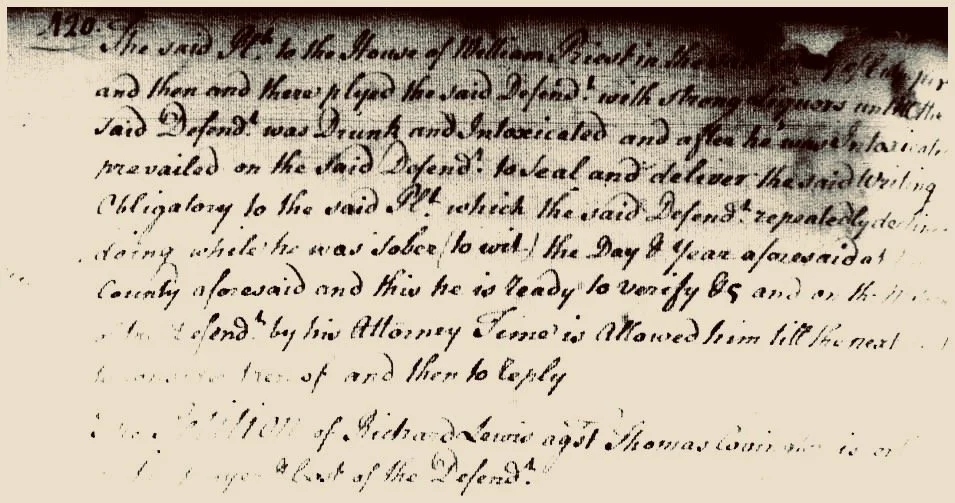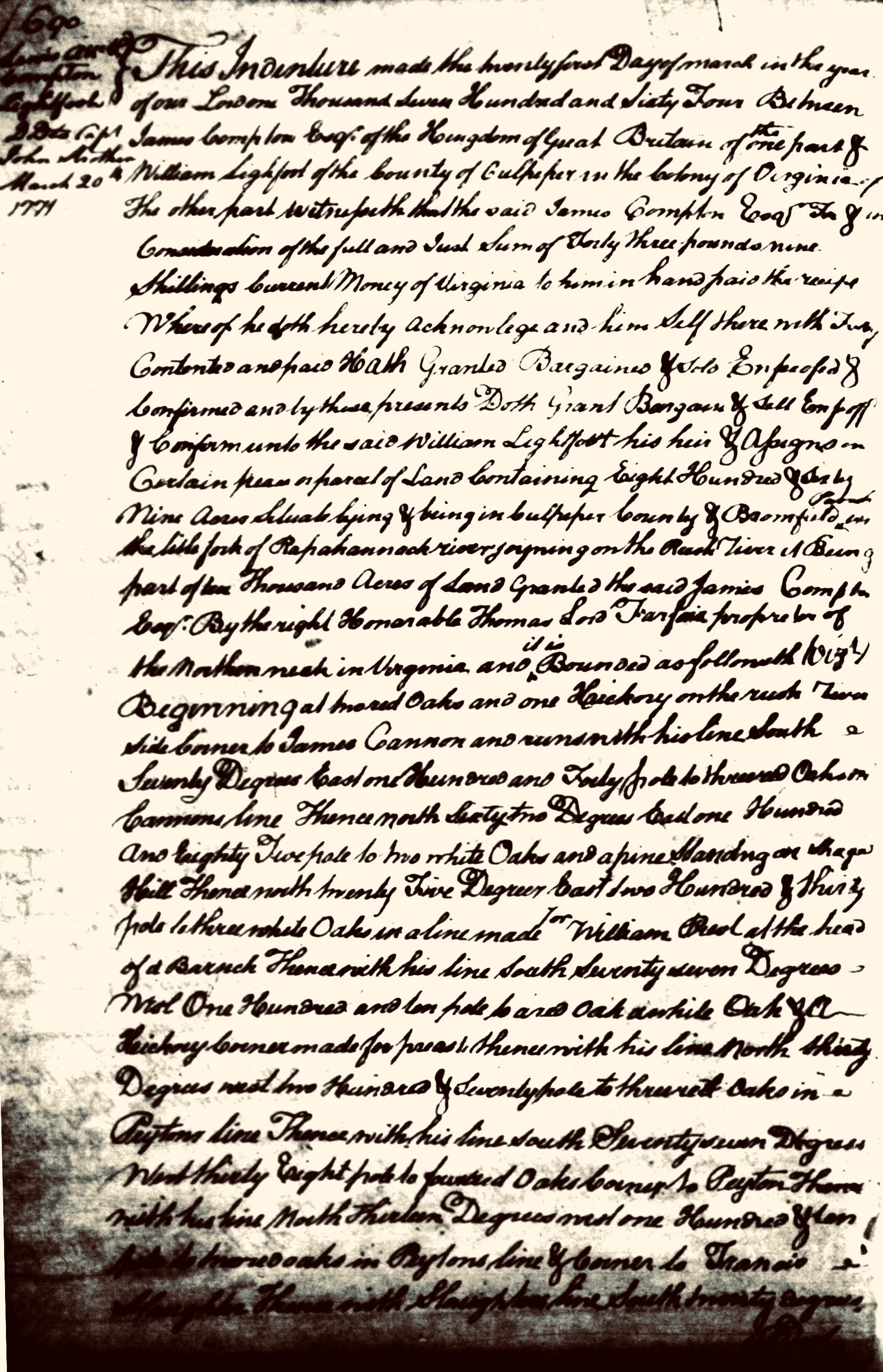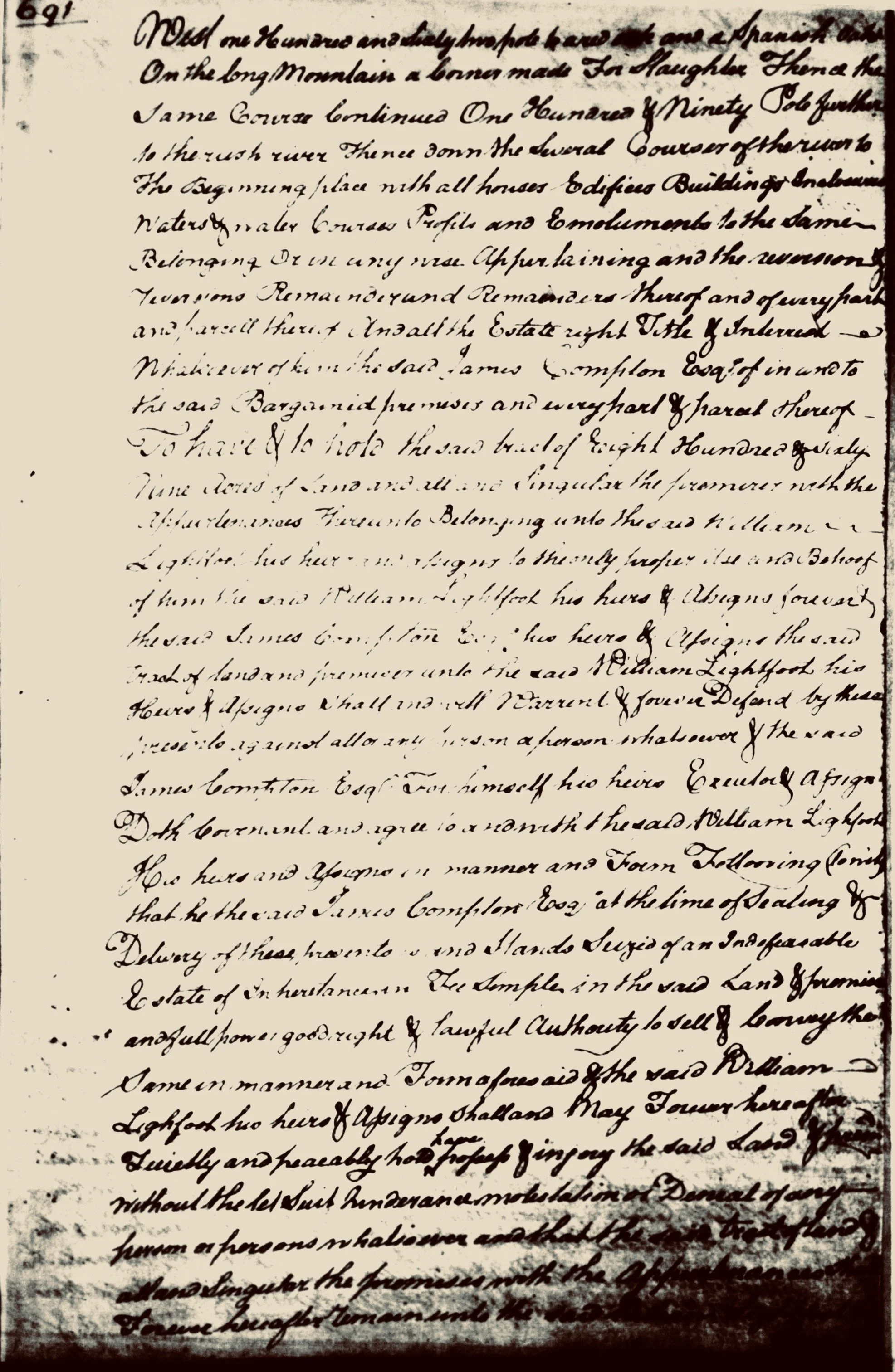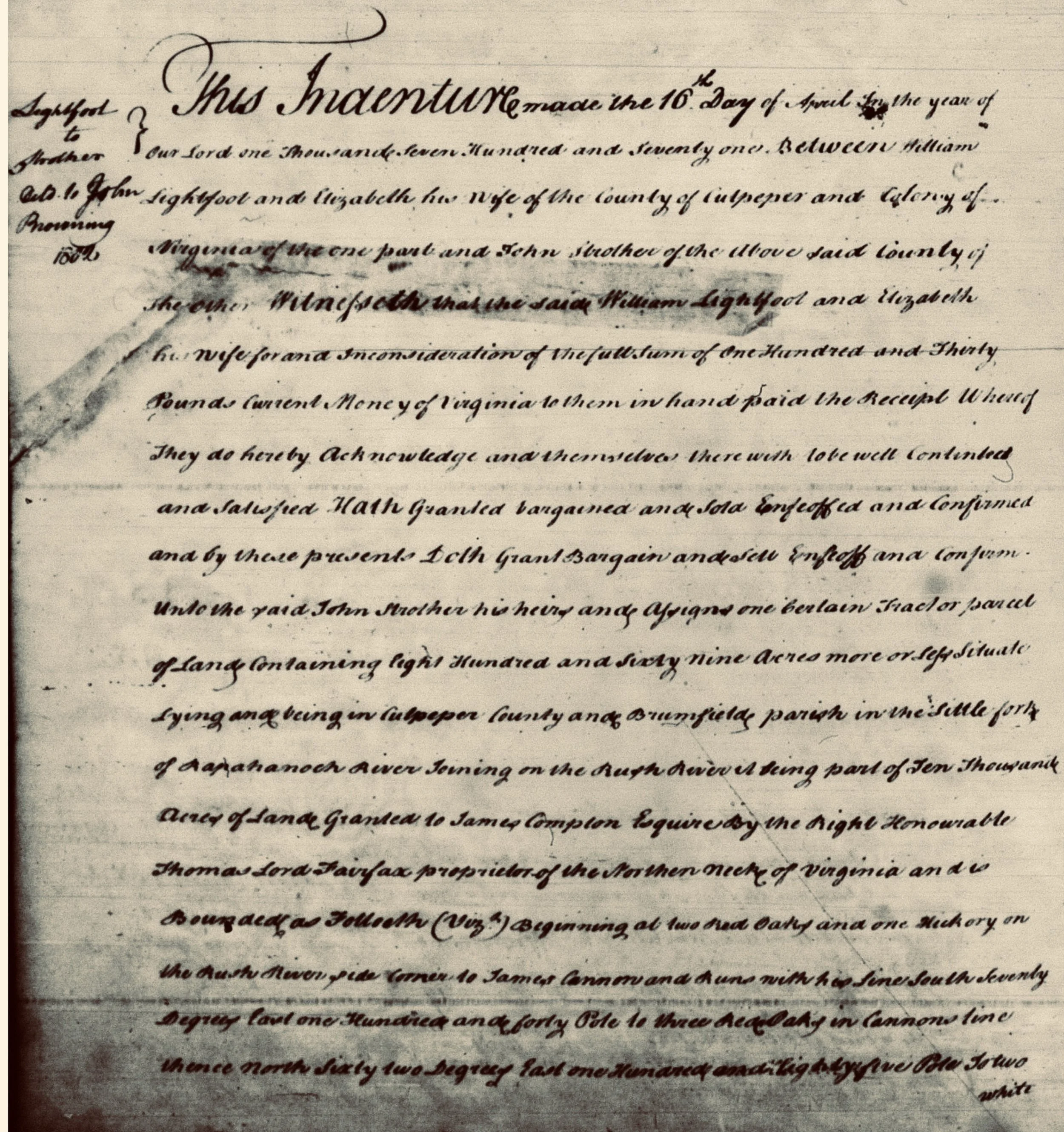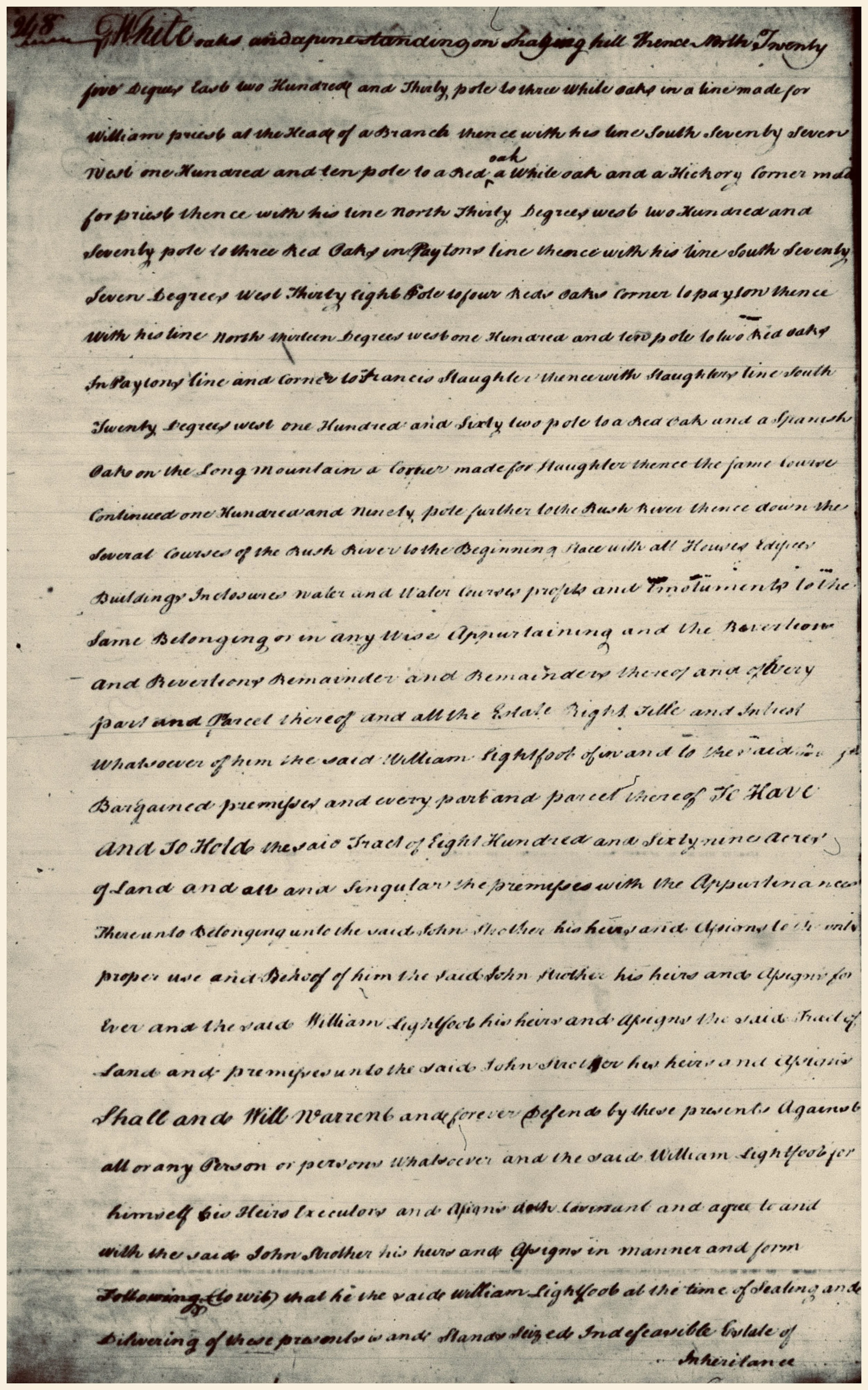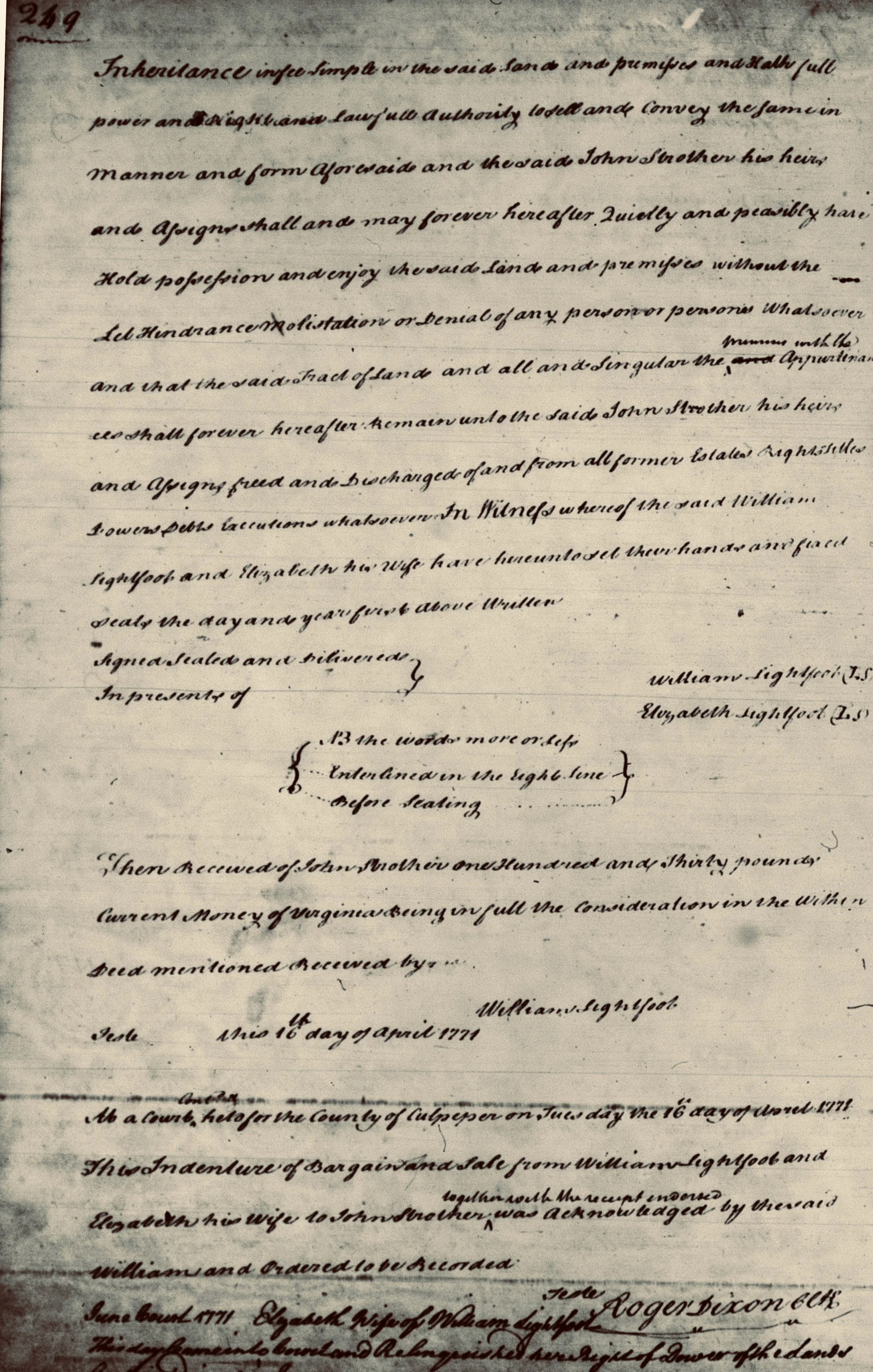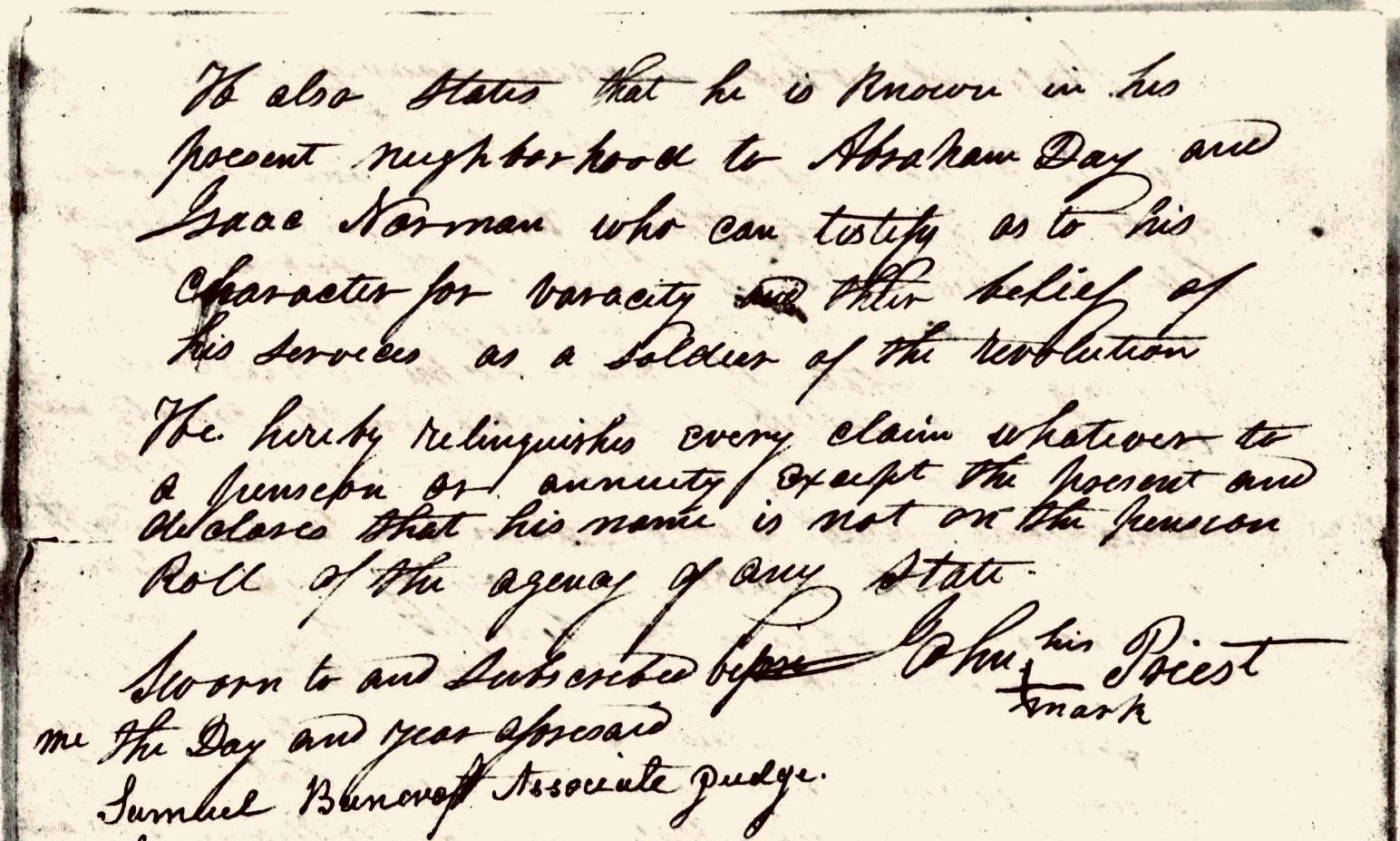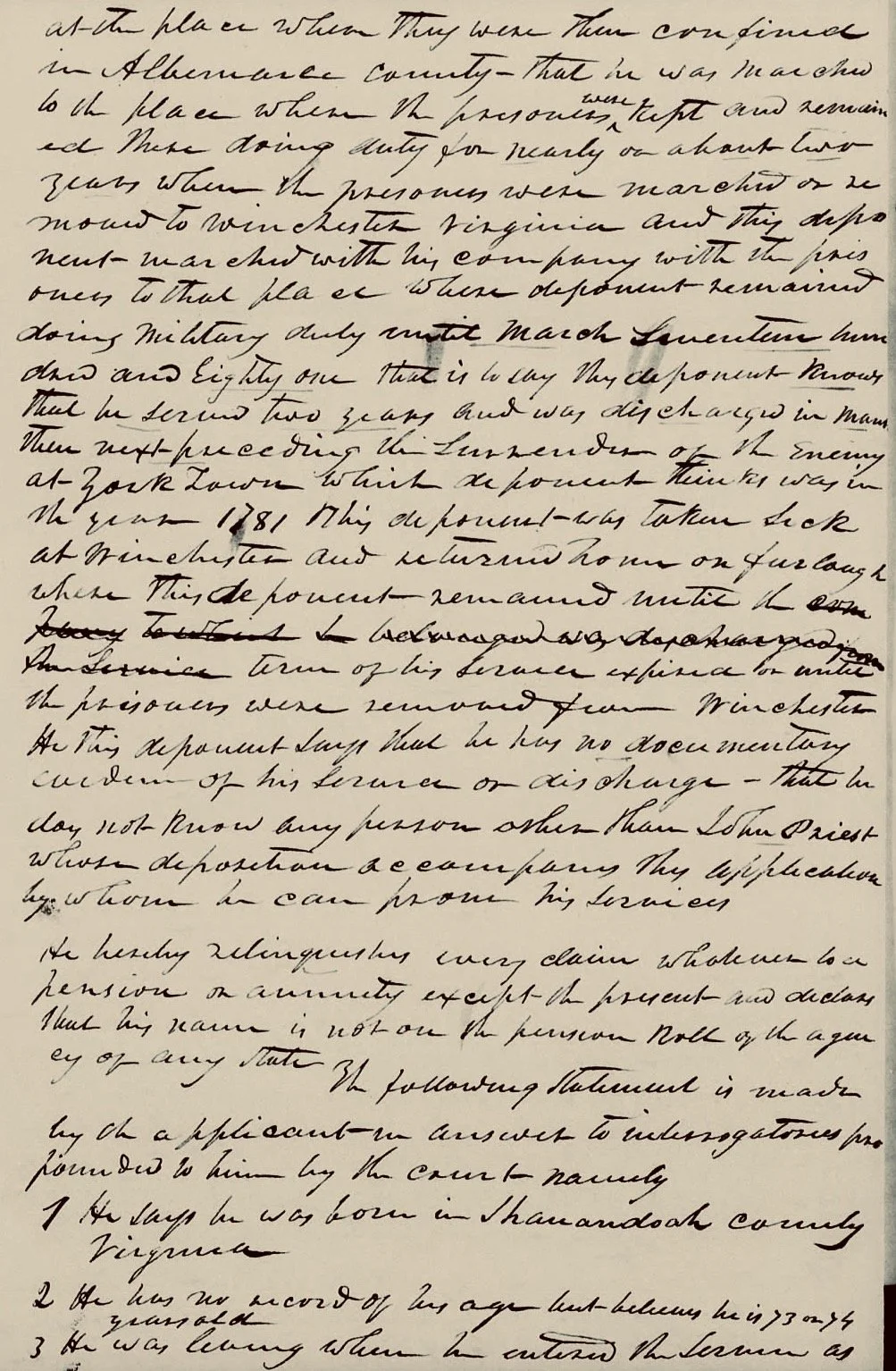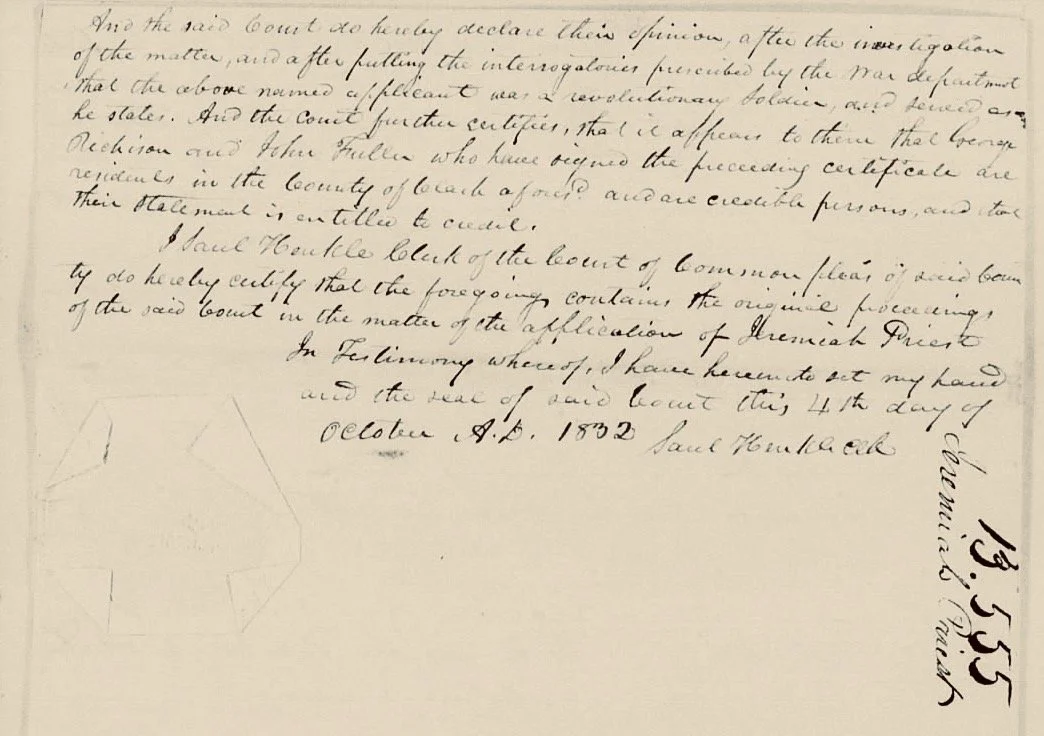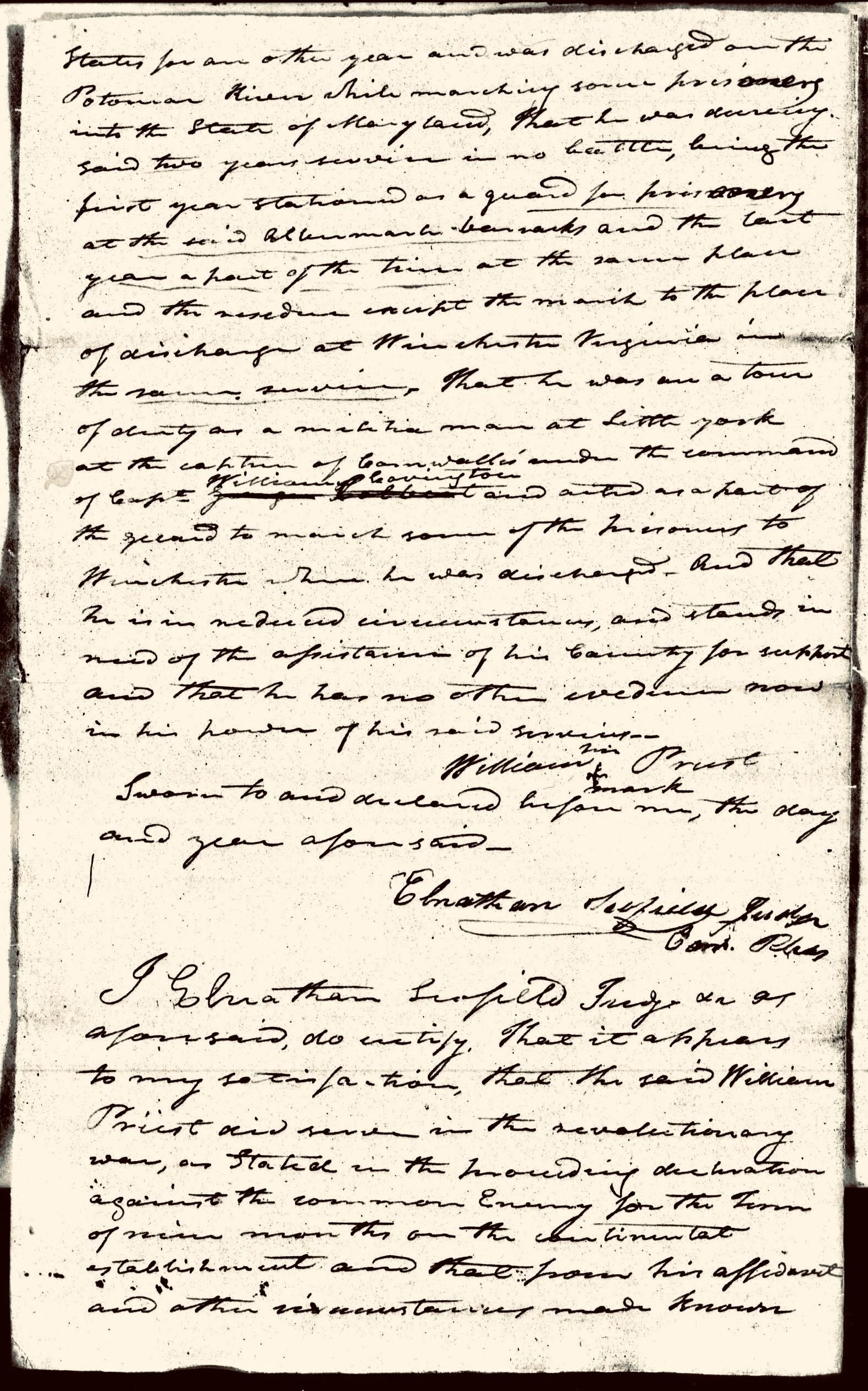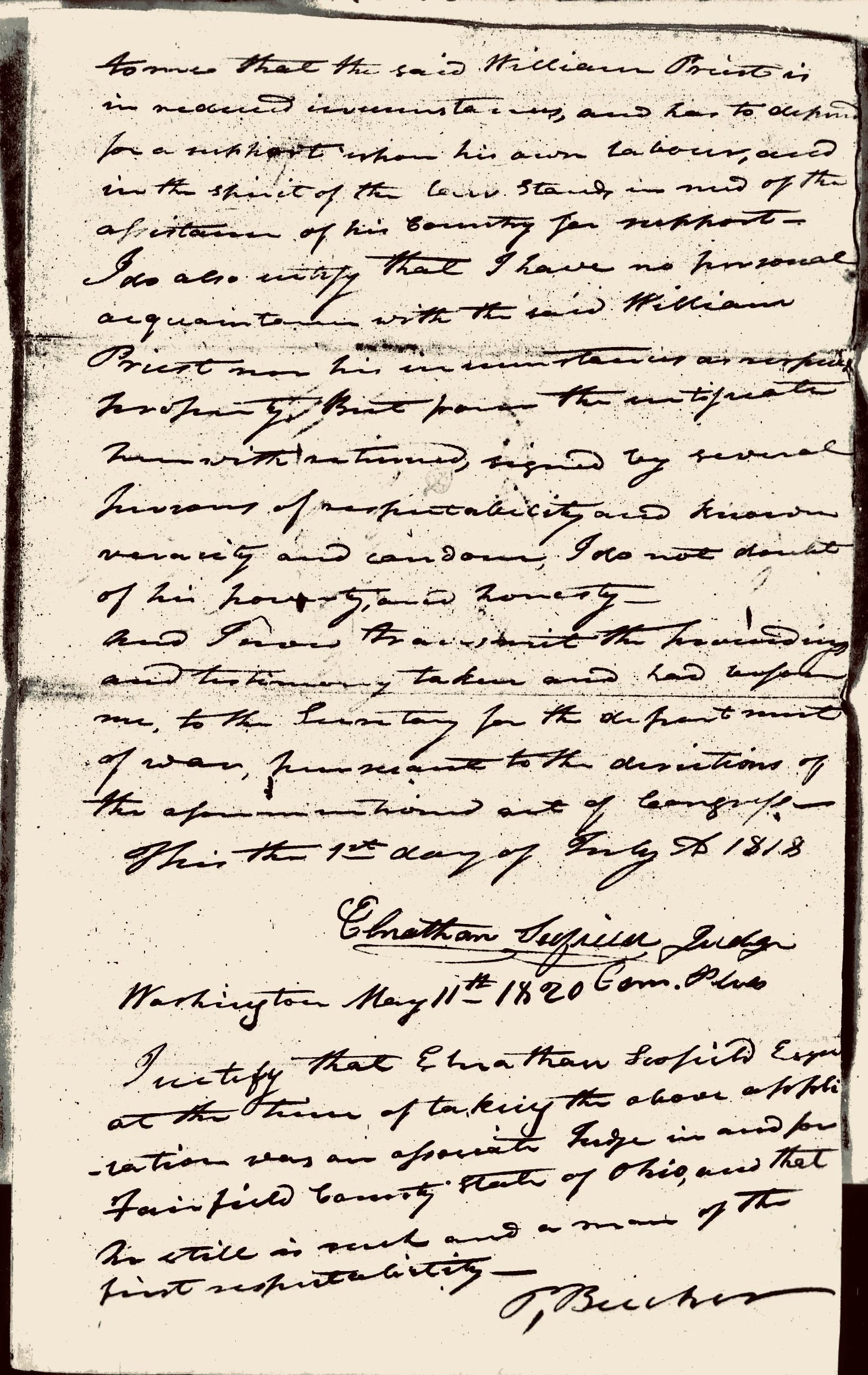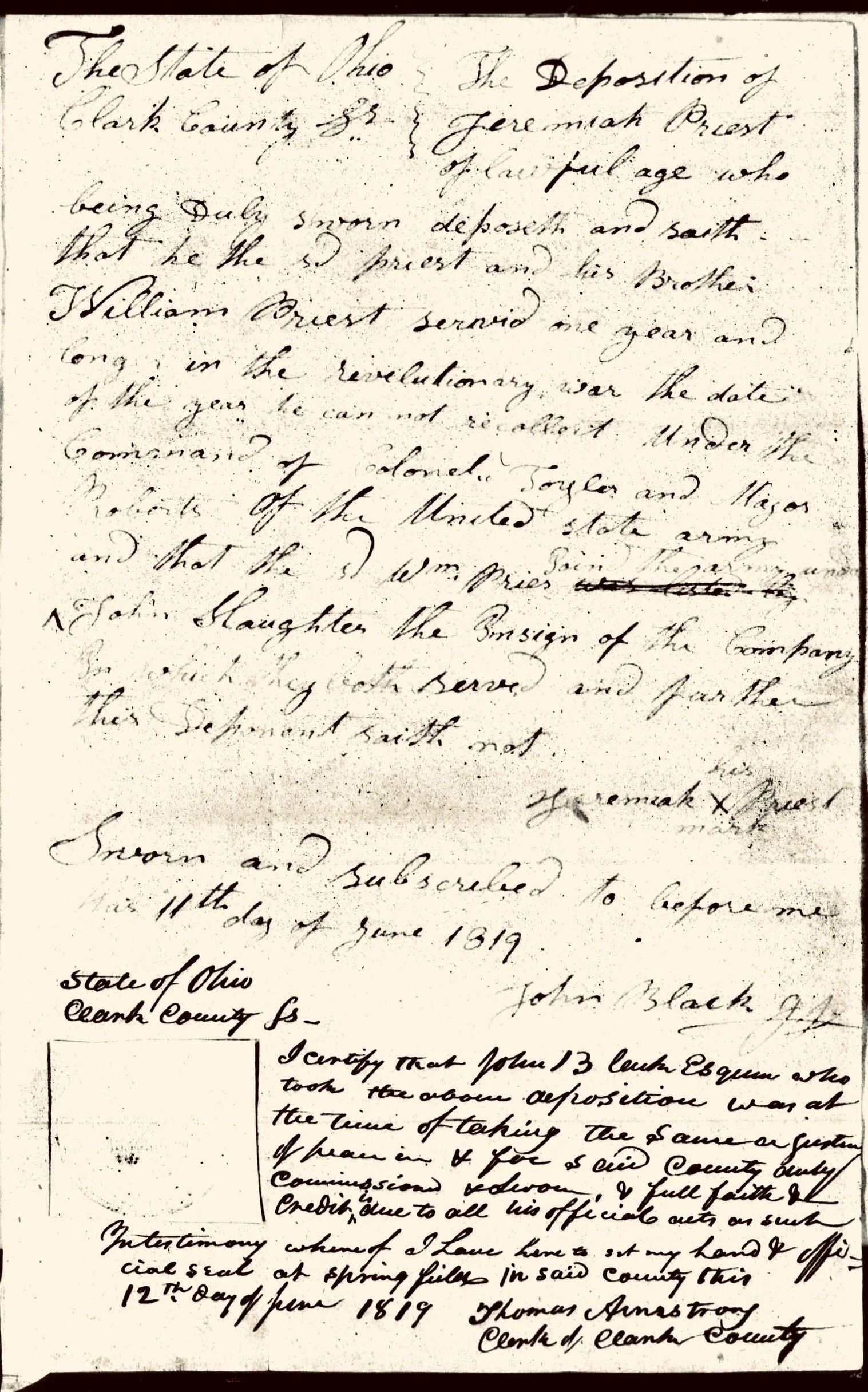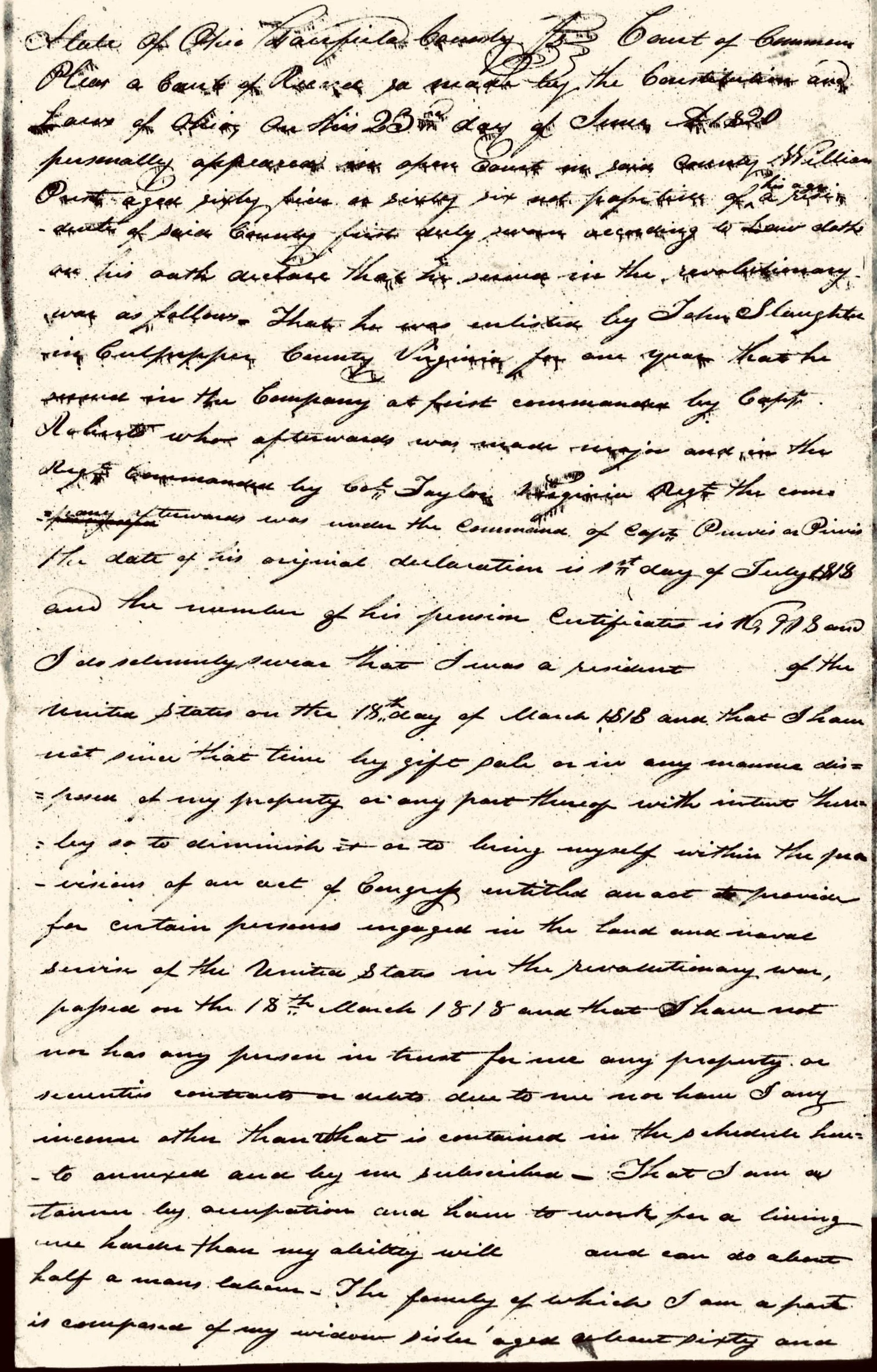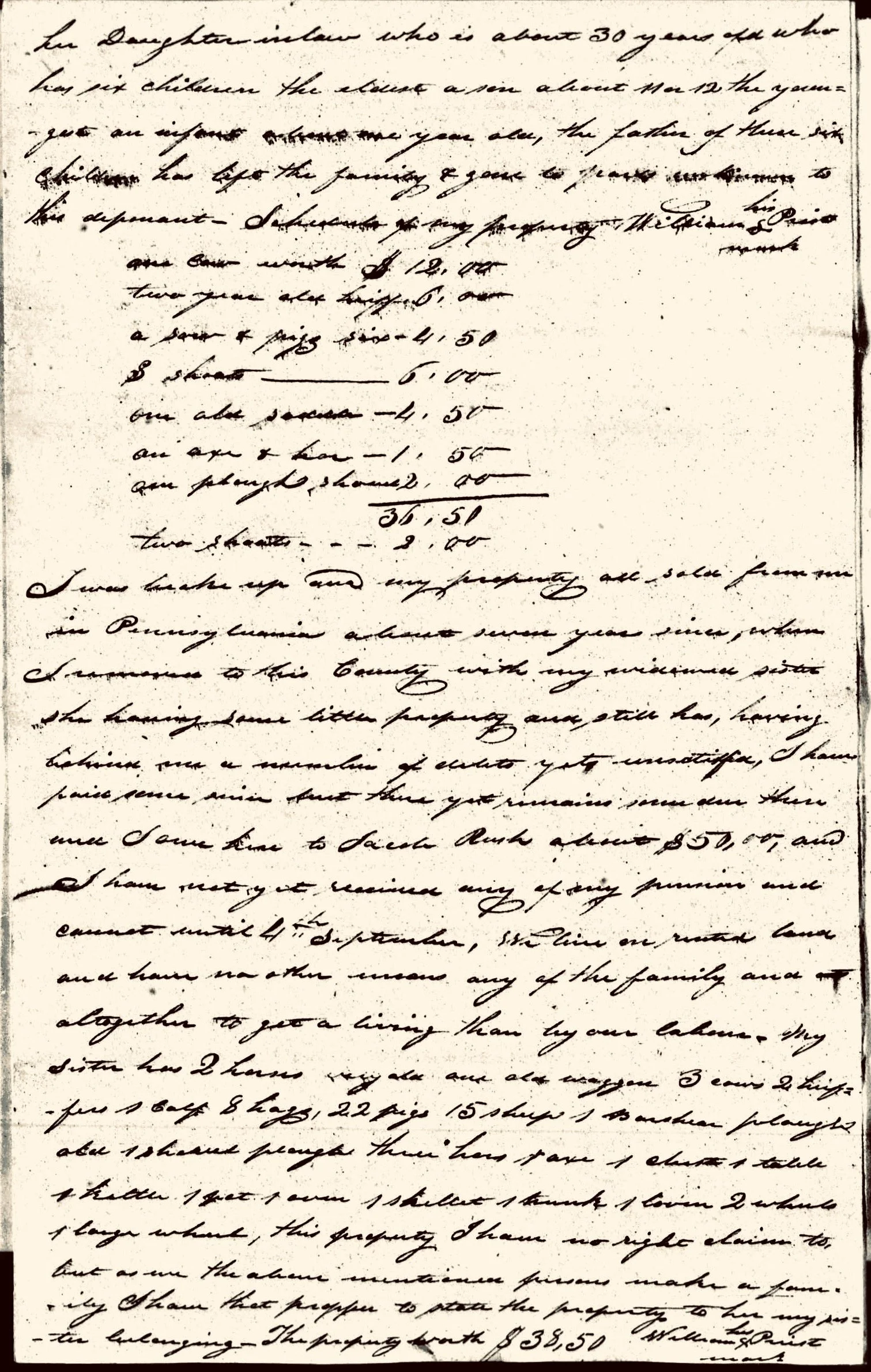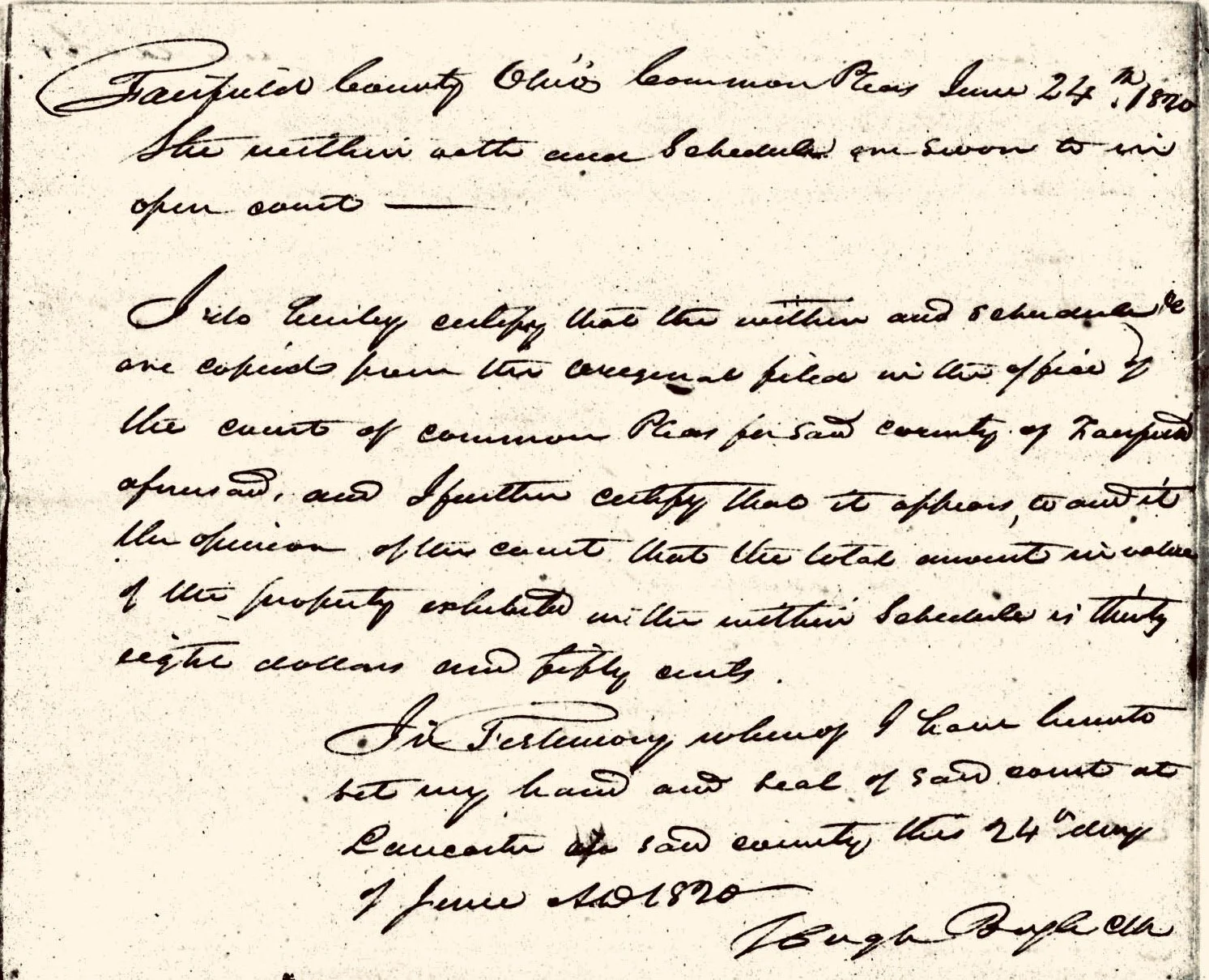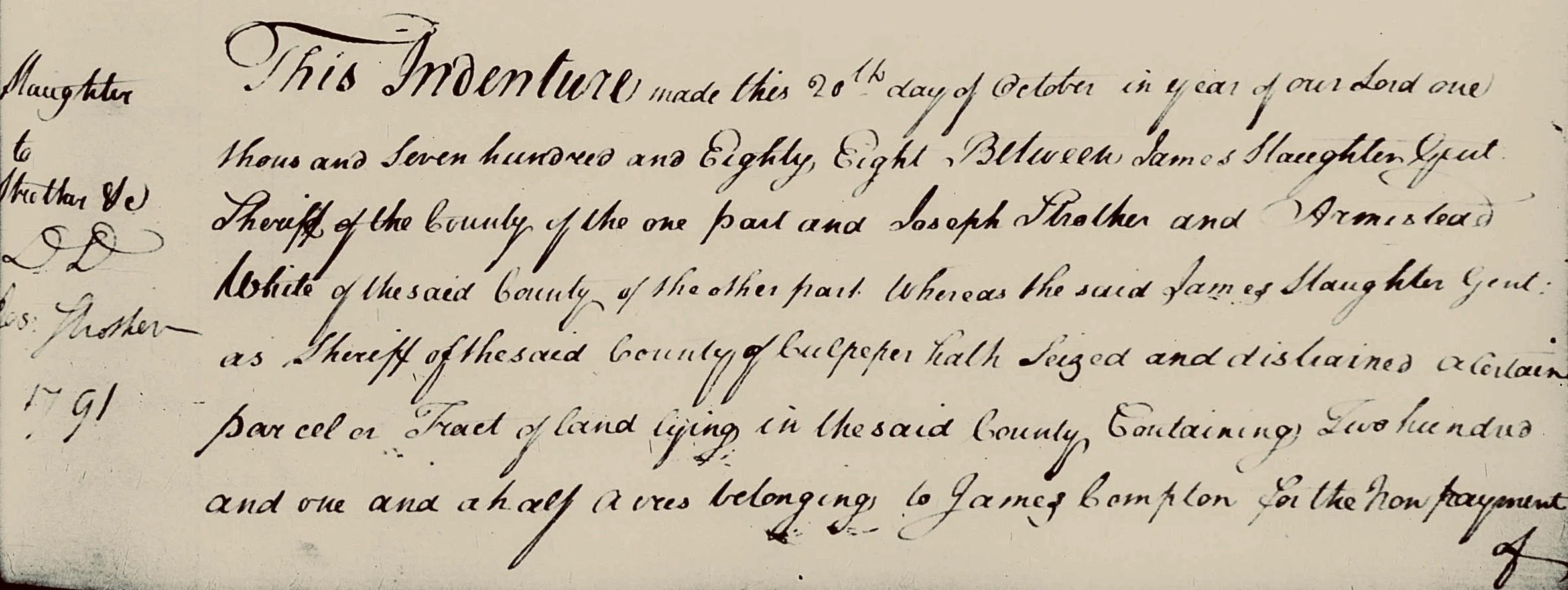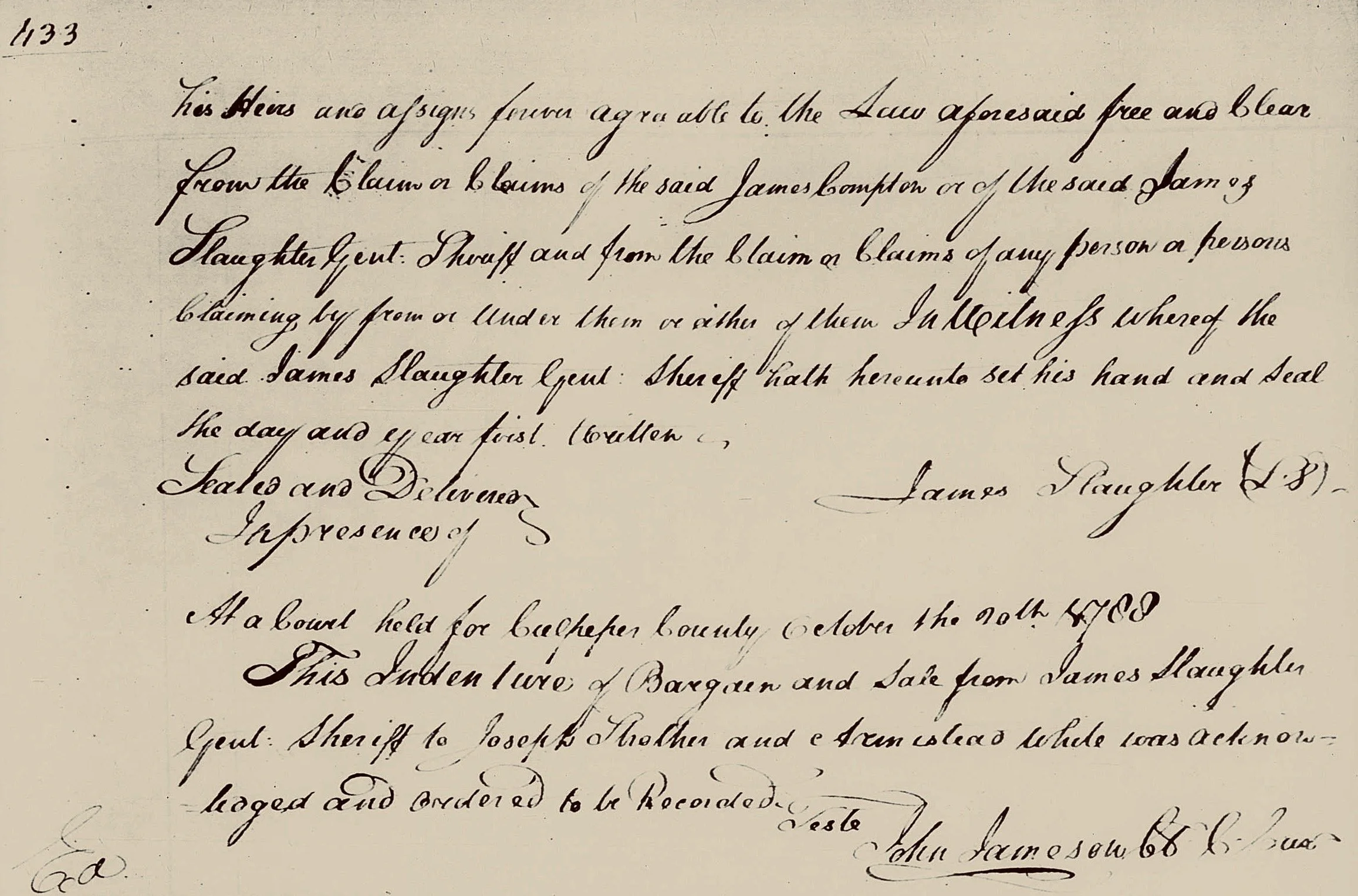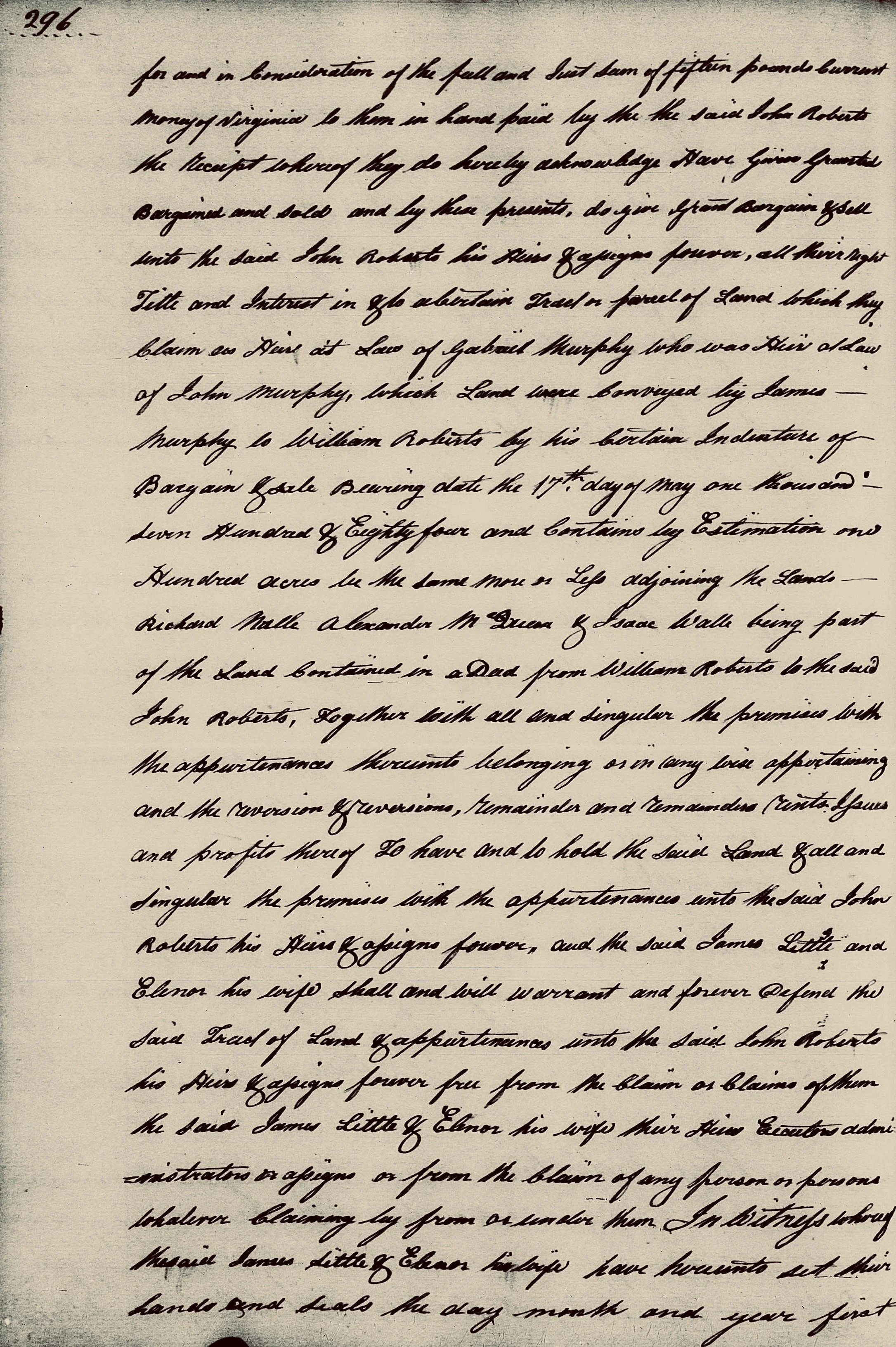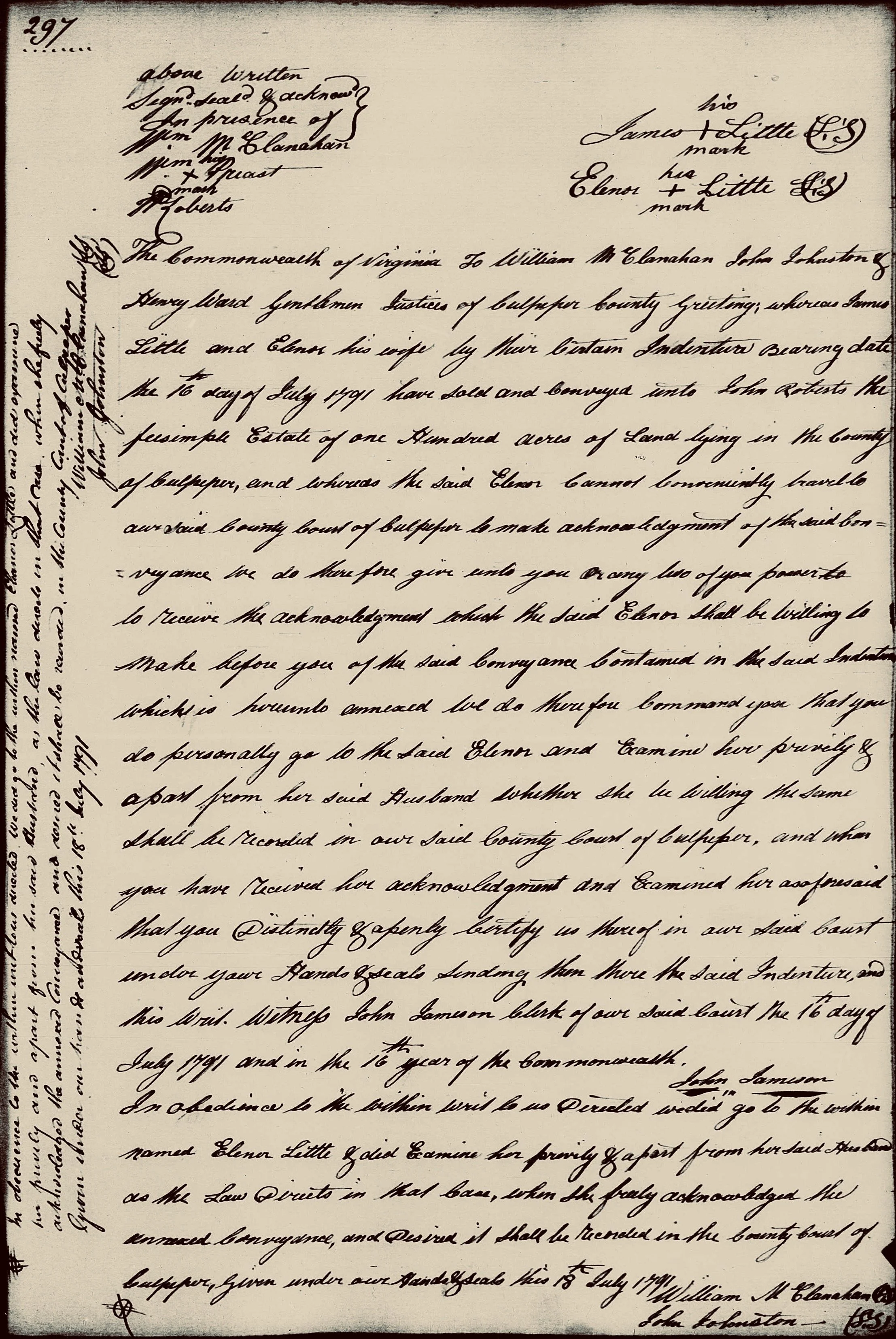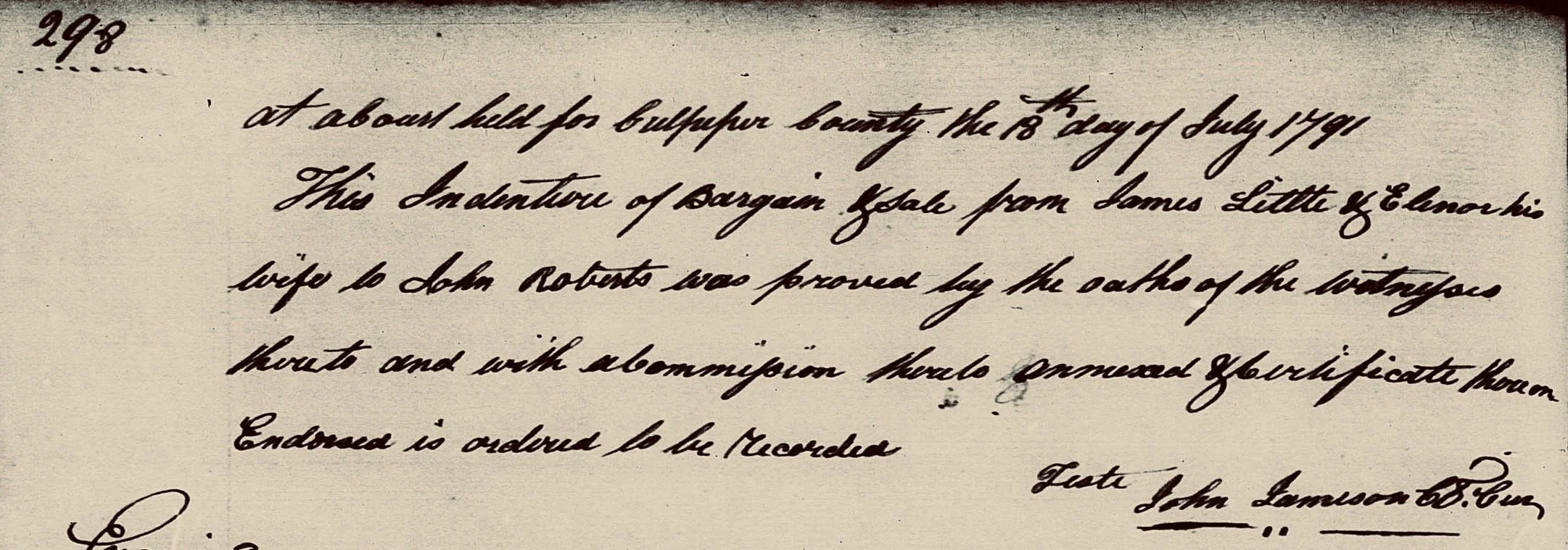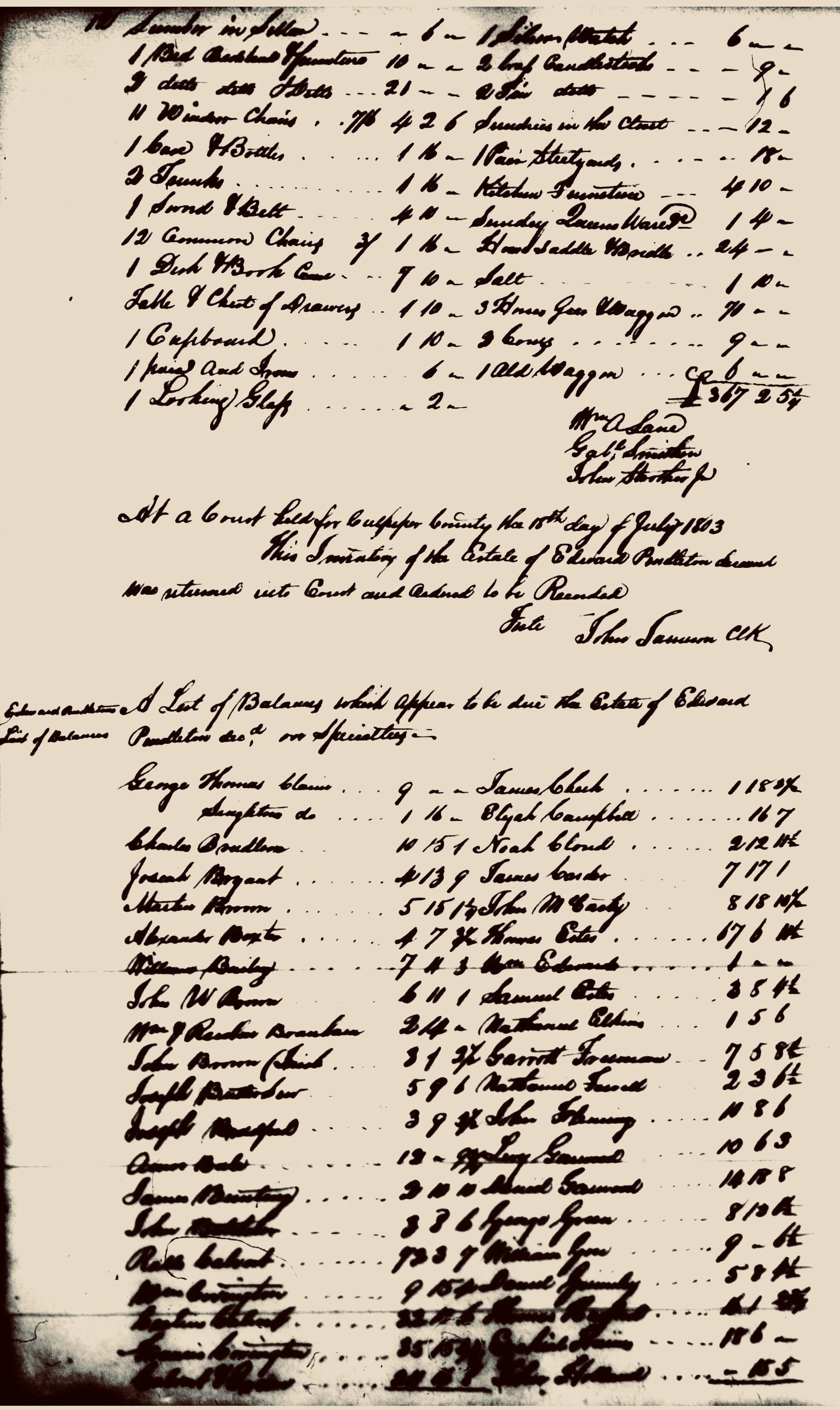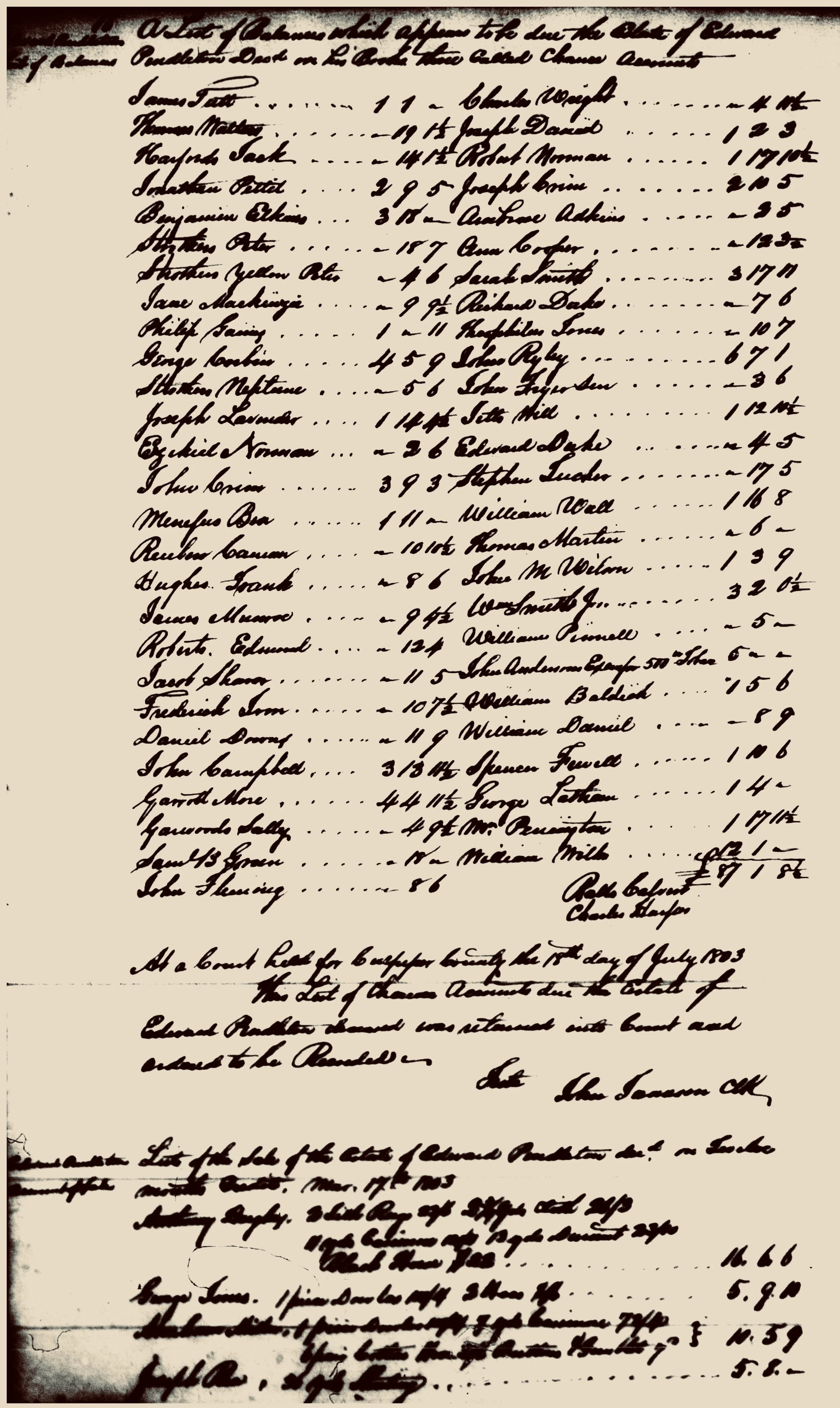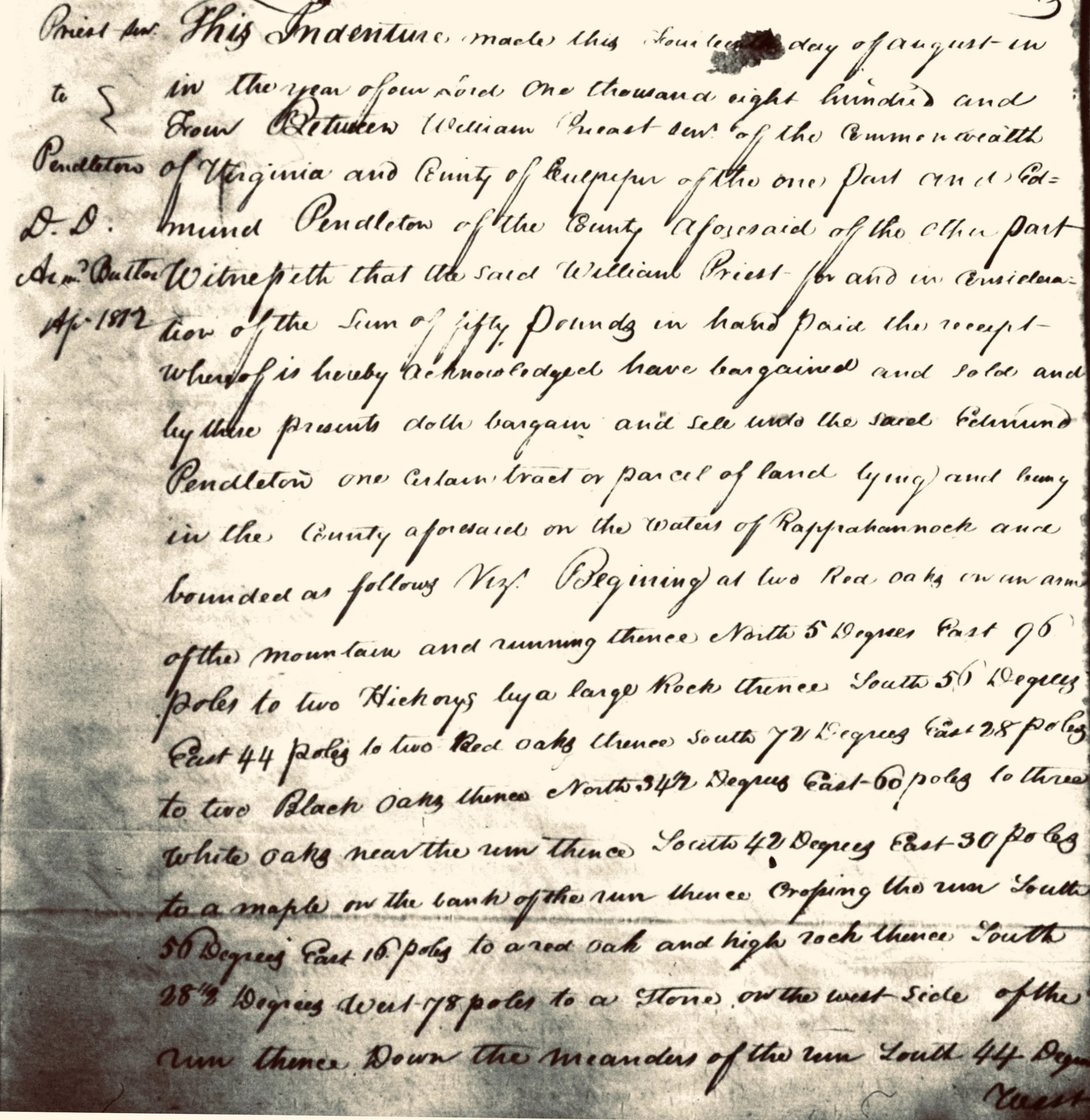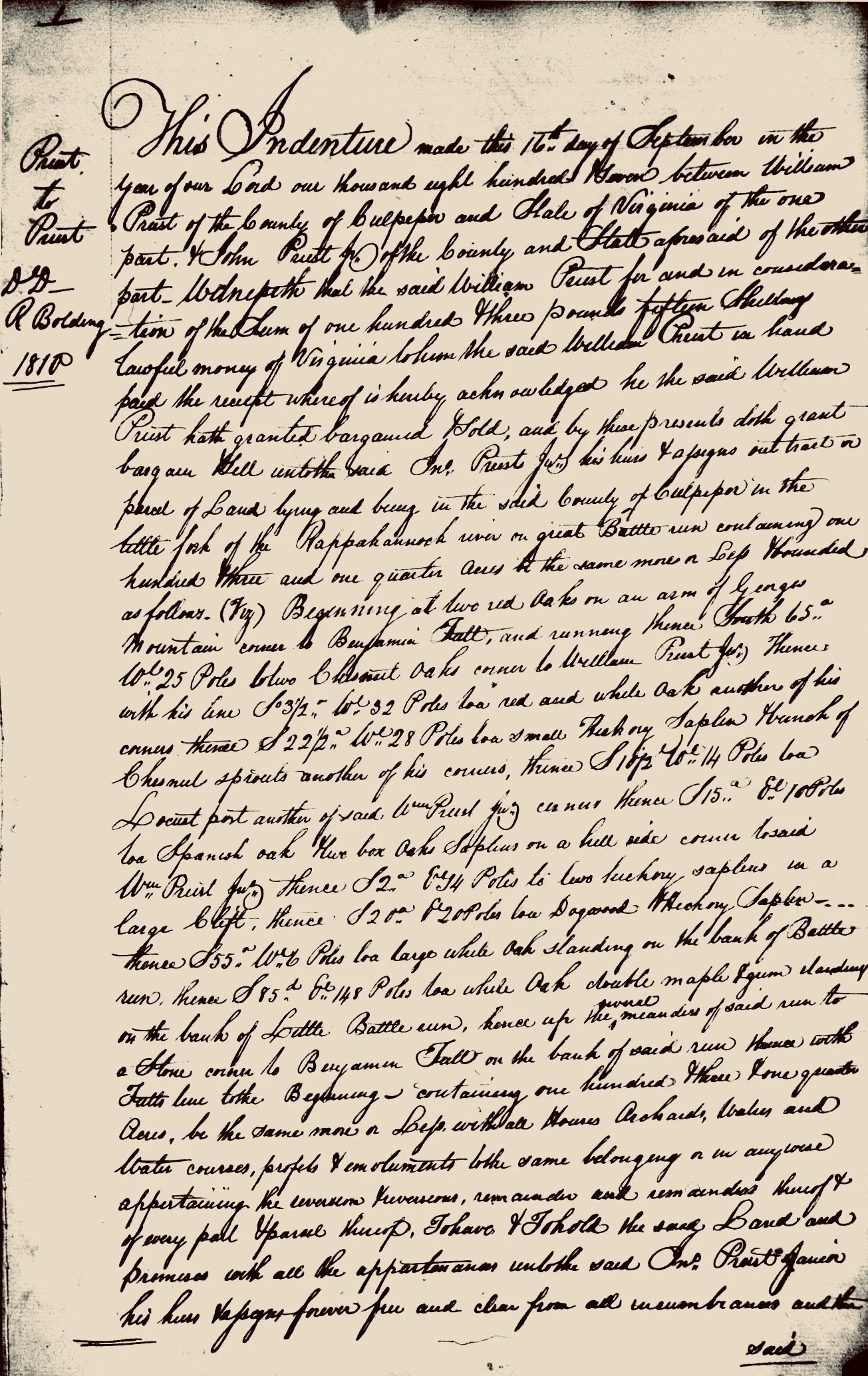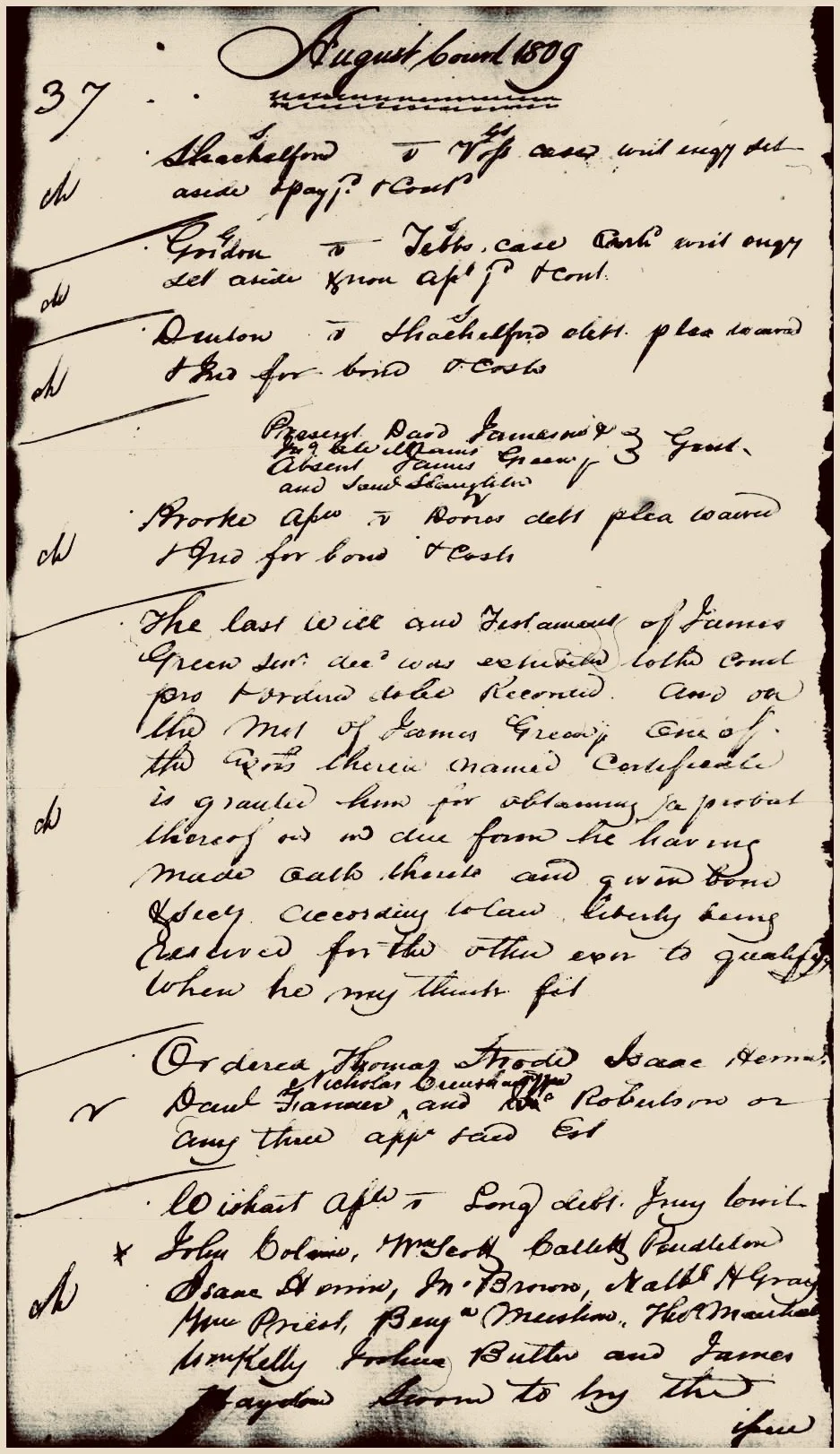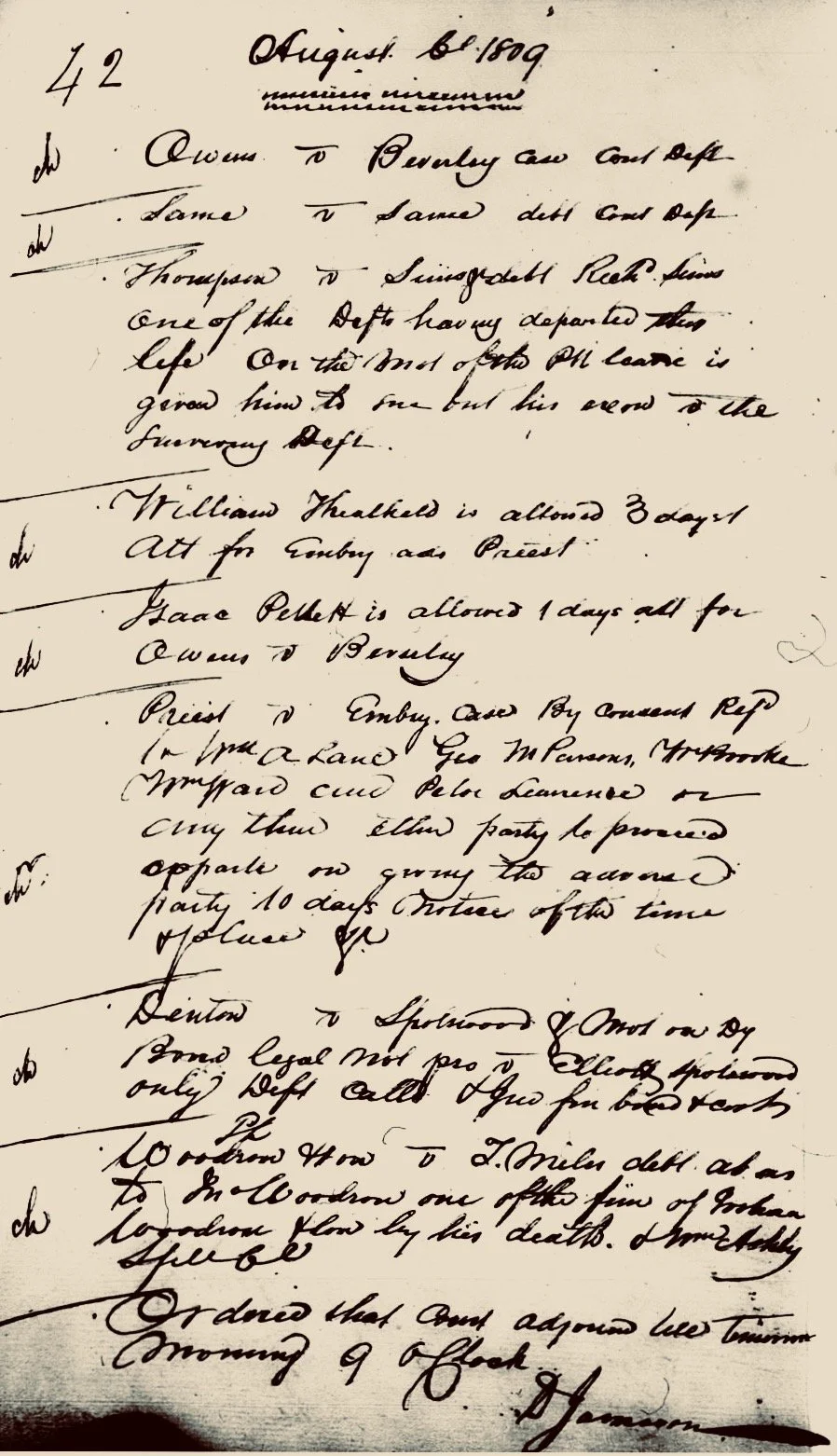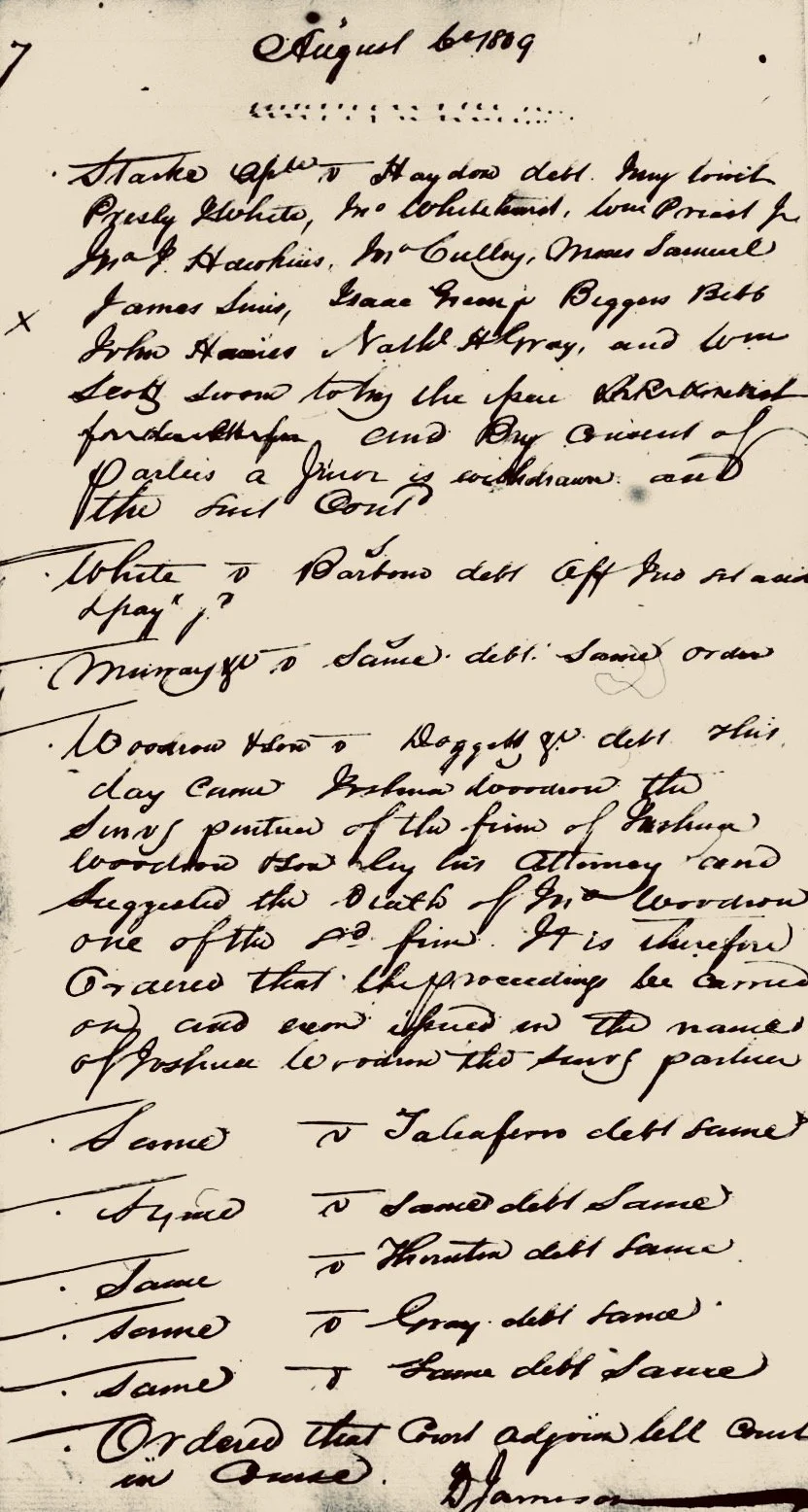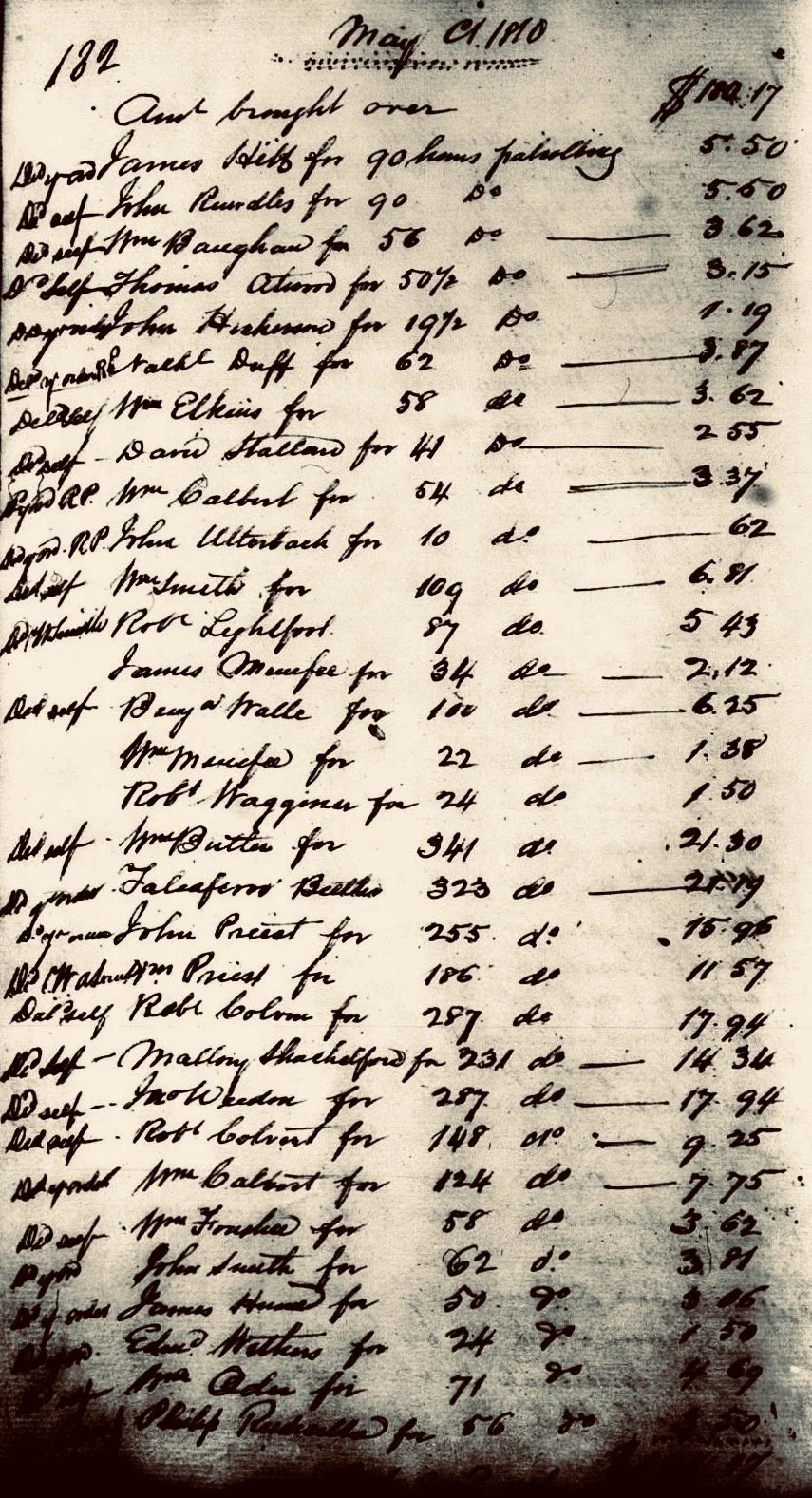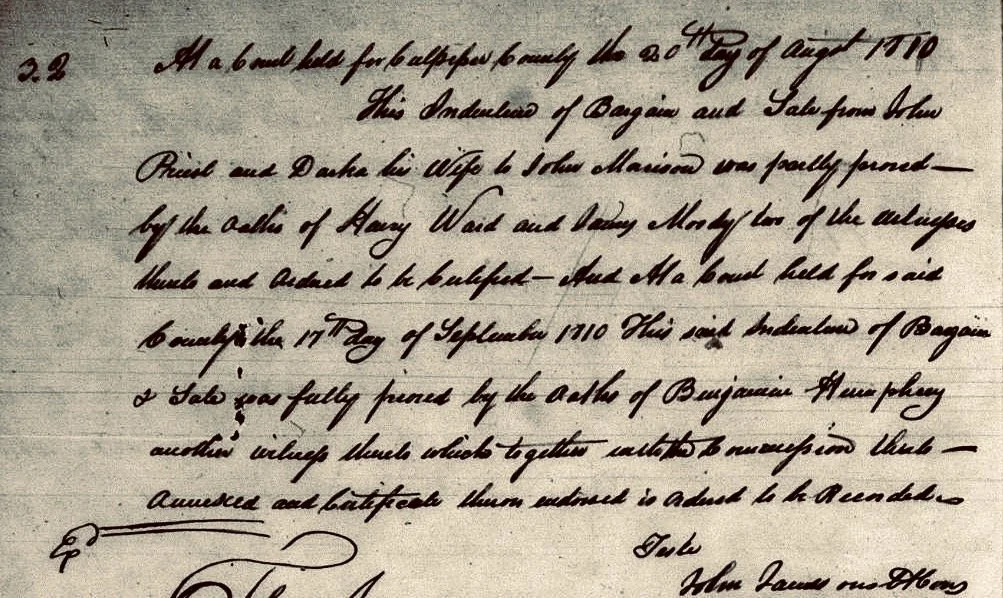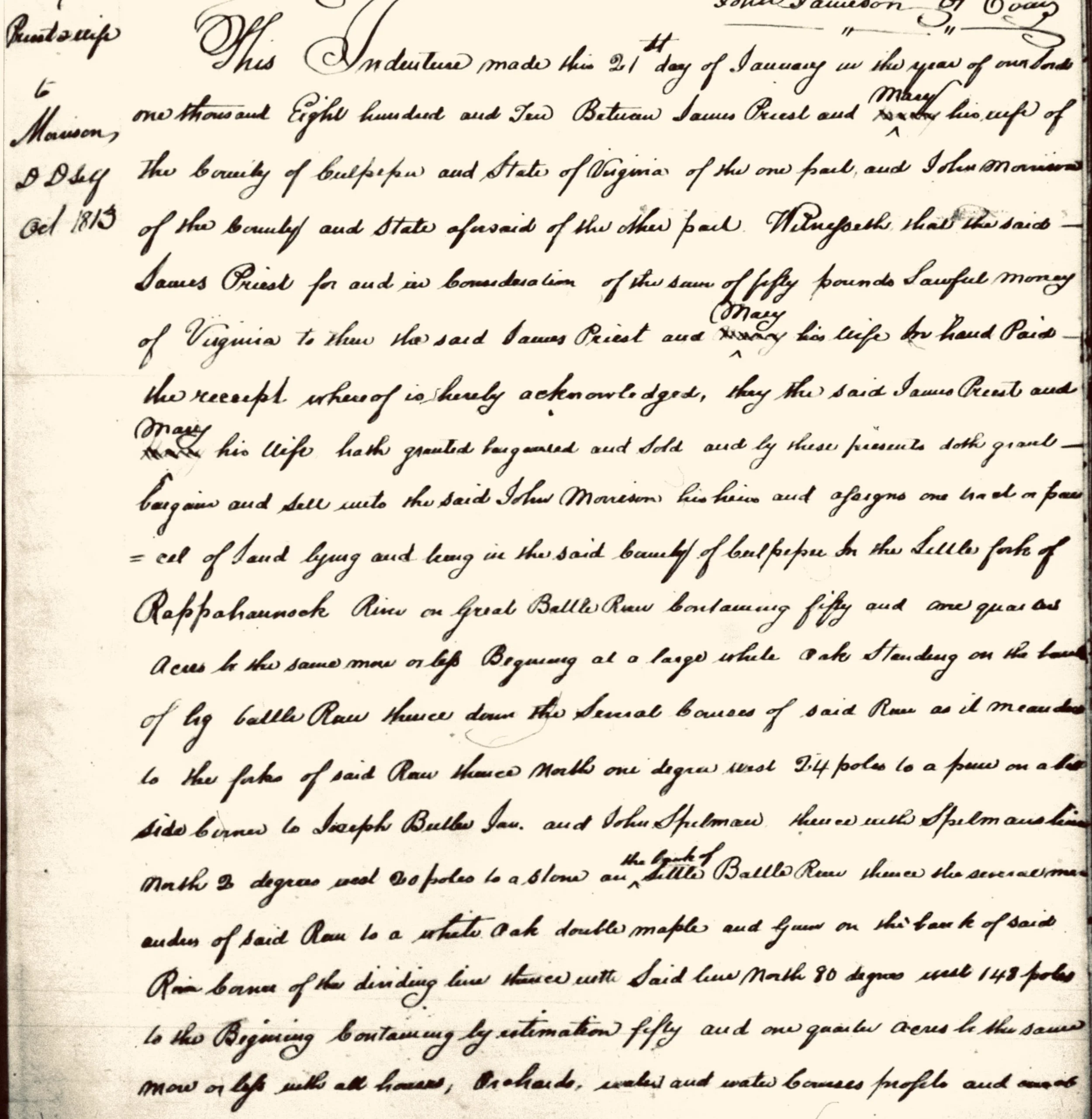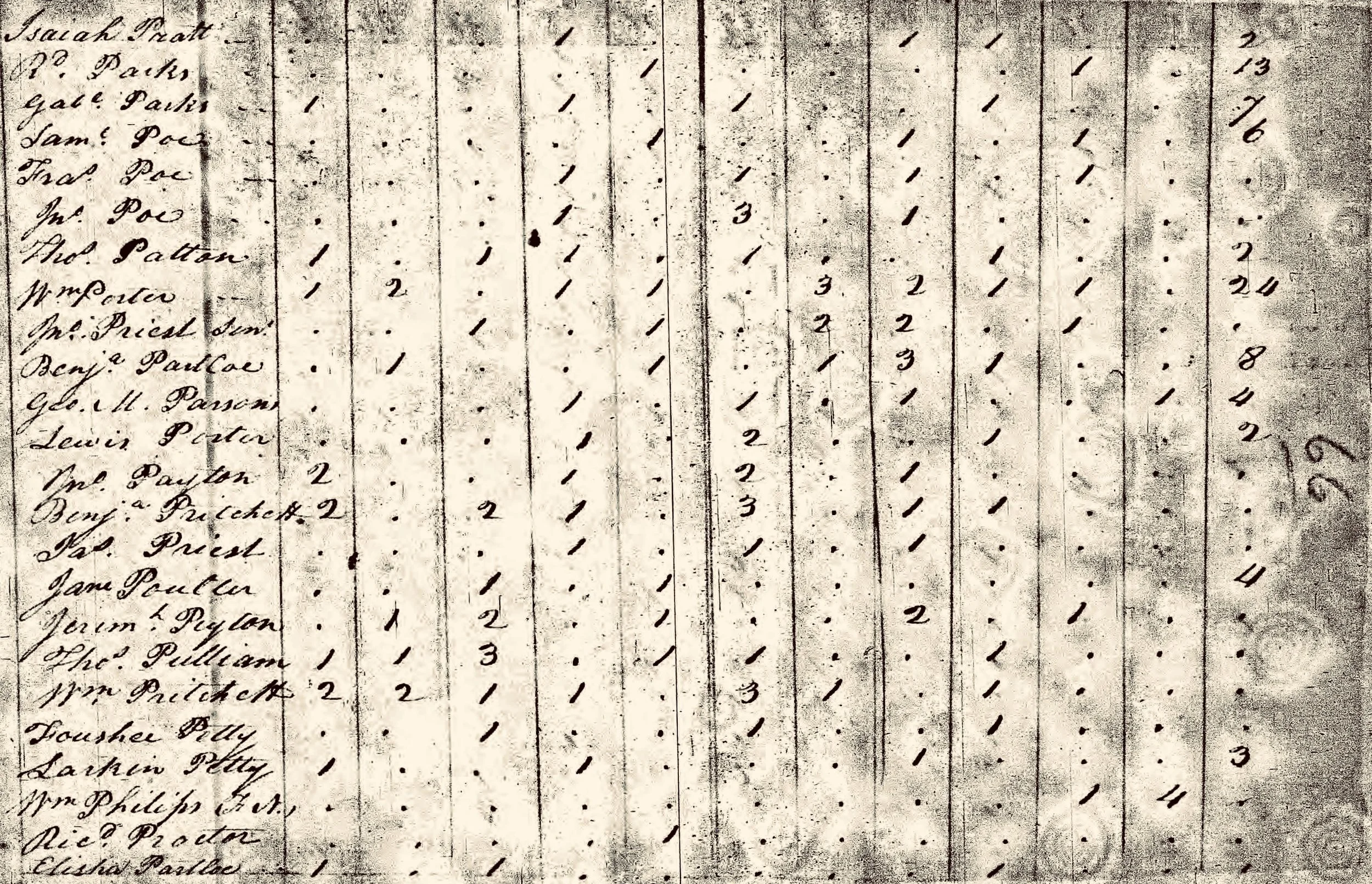Catherine Priest, the ninth known child of John Priest, was born in Culpeper County in the 1794-95 period.
Hankey Priest, second oldest known child of William Priest Jr., born in Culpeper County.
1795. Land tax records for this year show that John Priest is taxed for 118 acres, William Priest Sr. for 232 acres, and that John Priest is also paying the tax on the 132 acres formerly taxed to William Priest.
1795 Personal Property Tax Records (from microfilm):
Headings: Date of Receiving List from Individual; Persons Names Chargable with the Tax(under this heading the names are listed); White males above 16 years old; Blacks over 16; blacks over 12 and under 16; horses, etc.; carriage wheels; # of stud (?) horses; rates of covering per season(?).
April 28 – Stanley Priest, 1, -, -, -, all the rest blank (one white male over 16)
April 28 – William Priest Jr., William Priest, Sen., 2, -, -, 1, all the rest blank. (two white males over 16, 1 horse, etc.)
April 28 – John Priest, 1, -, -, 1, all the rest blank. (one white male over 16, 1 horse, etc.)
April 28 – William Priest, son of (?) John, 1, -, -, -1 all the rest blank. (one white male over 16, one horse, etc.)
NOTE: This is the last year since William Priest, the son of John, came of age in 1791 and is shown in the tax records – that there are three William Priests. In the years after this, only two William Priests are shown. It appears that the patriarch William Priest died about this time – leaving his son and John’s son as the two William Priests still shown in tax records. In the earlier references to land tax records, John Priest paid the land tax for the patriarch William from 1794 to 1797.
Elizabeth Priest, third oldest known child of William Priest Jr., born in Culpeper County.
1796. Land tax records for this year show that John Priest is taxed for 118 acres, William Priest Sr. for 232 acres, and that John Priest is also paying the tax on the 132 acres formerly taxed to William Priest. [The fact that the term William Priest Sr. is sued, indicates that this now was applied in these records to William, the son of the original patriarch.]
1796 Personal Property Tax Records (from microfilm):
Headings: Date of Receiving List from Individual; Persons Names Chargable with the Tax(under this heading the names are listed); White males above 16 years old; Blacks over 16; blacks over 12 and under 16; horses, etc.; carriage wheels; # of stud (?) horses; rates of covering per season(?).
May 14 – William Priest, 1, -, -, -, all the rest blank. (one white male over 16)
May 14 – William Priest, 1, -, -, -1 all the rest blank. (one white male over 16, one horse, etc.)
May 14 – Stanley Priest, 1, -, -, 1, all the rest blank (one white male over 16, 1 horse, etc.)
May 14 – John Priest, 1, -, -, 1, all the rest blank. (one white male over 16, 1 horse, etc.)
1797. Land tax records for this year show that John Priest is taxed for 118 acres, William Priest Sr. for 232 acres, and that John Priest is also paying the tax on the 132 acres formerly taxed to William Priest. This appears to be the same in 1797.
1797 Personal Property Tax Records (from microfilm):
Headings: Date of Receiving List from Individual; Persons Names Chargable with the Tax (under this heading the names are listed); White males above 16 years old; Blacks over 16; blacks over 12 and under 16; horses and mares, cattle and mules; # of stud (?) horses; rates of covering per season(?), two more categories that are unclear.
May 10 – Stanley Priest, 1, -, -, -, all the rest blank (one white male over 16)
May 10 – William Priest, 1, -, -, -3 all the rest blank. (one white male over 16, three horses, cattle and others.)
May 10 – John Priest, 2, -, -, 2, all the rest blank. (two white males over 16, 2 horses, cattle, and other)
May 25 – William Priest, 1, -, -, -, all the rest blank (one white male over 16)
1798. 1798 Personal Property Tax Records (from microfilm):
Headings: Date of Receiving List from Individual; Persons Names Chargable with the Tax (under this heading the names are listed); White males above 16 years old; Blacks over 16; blacks over 12 and under 16; horses, etc.; # of stud (?) horses; rates of covering per season(?), three more categories that are unclear, and then two columns for the amount of tax – dollars and cents.
April 7 – John Priest, 2, -, -, 2, all the rest blank, nine cents tax. (two white males over 16, 2 horses, etc.)
April 7 – William Priest, 1, -, -, -, all the rest blank, no tax (one white male over 16)
April 10 (?) – William Priest, 1, -, -, 1, all the rest blank, nine cents tax (one white male over 16, one horse, etc.)
April 10 (?) – Stanley Priest, 1, -, -, -, all the rest blank, no tax (one white male over 16)
In Land Tax Records, William Priest Sr. is paying land tax this year on the 232 acres. This is the first year that he is the only Priest paying land tax, with John Priest dropping off the rolls for the two parcels on which he was previously paying land tax.
Susan(nah) Priest, the tenth known child of John Priest, was born in the 1798-99 period in Culpeper County.
1799. 1799 Personal Property Tax Records (from microfilm):
Headings: Date of Receiving List from Individual; Persons Names Chargable with the Tax (under this heading the names are listed); White males above 16 years old; Blacks over 16; blacks over 12 and under 16; horses, mares, cattle, and mules; stud horses; rates of covering per season(?), three more categories that are unclear, and then two columns for the amount of tax – dollars and cents.
April 13 – Stanley Priest, 1, -, -, 1, all the rest blank, twelve cents tax (one white male over 16, 1 horse and others)
May 25 – William Priest, Jr., 1, -, -, 1, all the rest blank, no tax amount (one white male over 16, one horse, etc.)
May 29 – William Priest, 1, -, -, 3, all the rest blank, twelve cents tax (one white male over 16, three horses, etc.)
May 25 – John Priest, 2, 1, -, 2, all the rest blank, fifty-six cents tax. (two white males over 16, 1 black over 16; 2 horses, and others)
In Land Tax Records, William Priest Sr. is paying land tax this year on the 232 acres. He is the only Priest listed this year in these records.
1800. The 1800 census for Virginia is lost, so there are no Culpeper County Priest entries to compare to these other records.
1800 Personal Property Tax Records (from microfilm):
Headings: Date of Receiving List from Individual; Persons Names Chargable with the Tax (under this heading the names are listed); White males above 16 years old; Blacks over 16; blacks over 12 and under 16; horses, mares, cattle, and mules; No. of stud horses; rates of covering per season(?), three more categories that are unclear, and then two columns for the amount of tax – dollars and cents.
May 17 – John Priest, 2, -, -, 1, all the rest blank, twelve cents tax. (two white males over 16; 1 horse, and others)
June 14 – William Priest, 1, -, -, 1, all the rest blank, twelve cents (one white male over 16, one horse, etc.)
April 20 (?) – William Priest, 1, -, -, 1, all the rest blank, twelve cents (one white male over 16, one horse, etc.)
April 20 (?) – Stanly (sic) Priest, 1, -, -, 1, all the rest blank, twelve cents (one white male over 16, one horse, etc.)
In Land Tax Records, William Priest Sr. is paying land tax this year on the 232 acres. He is the only Priest listed this year in these records.
John Priest, fourth oldest known child of William Priest Jr., born in Culpeper County.
1801. 1801 Personal Property Tax Records (from microfilm):
Headings: Date of Receiving List from Individual; Persons Names Chargable with the Tax (under this heading the names are listed); White males above 16 years old; Blacks over 16; blacks over 12 and under 16; horses, mares, goatts, and mules; ordinary licenses; stud horses; rates of covering per season(?), three more categories that are unclear, and then two columns for the amount of tax – dollars and cents.
May 20 – Stanley Priest, 1, -, -, 1, all the rest blank, twelve cents (one white male over 16, one horse, etc.)
May 20 – William Priest, 1, -, -, 1, all the rest blank, twelve cents (one white male over 16, one horse, etc.)
May 20 – William Priest, Jr., 1, -, -, 1, all the rest blank, twelve cents (one white male over 16, one horse, etc.)
May 20 – John Priest, 2, -, -, 1, all the rest blank, twelve cents (two white males over 16, one horse, etc.)
In Land Tax Records, William Priest Sr. is paying land tax this year on the 232 acres. He is the only Priest listed this year in these records.
1802. 1802 Personal Property Tax Records (from microfilm):
Headings: Date of Receiving List from Individual; Persons Names Chargable with the Tax (under this heading the names are listed); Number of tithables (? Not totally clear); Blacks over 16; blacks over 12 and under 16; horses; eight more categories that are unclear, tithables; and then two columns for the amount of tax – dollars and cents.
March 22 – John Priest 1, -, -, 1, all the rest blank, tax 12 cents.
March 22 – John Priest, Jr. 1, -, -, 1, all the rest blank, tax 12 cents.
March 22 – William Priest 1, -, -, -, all the rest blank, no tax.
March 22 – William Priest, Jr. 1, -, -, 1, all the rest blank, tax 12 cents.
March 22 – Stanley Priest 1, -, -, 1, all the rest blank, tax 12 cents.
In Land Tax Records, William Priest Sr. is paying land tax this year on the 232 acres. He is the only Priest listed this year in these records.
1803. 1803 Personal Property Tax Records (from microfilm)
Headings: Date of Receiving List from Individual; Persons Names Chargable with the Tax (under this heading the names are listed); White males above 16 years old; Blacks over 16; blacks over 12 and under 16; Number of horses;; the next four columns have the overall heading of carriage wheels and four subcategories; ordinary licenses; number of stud horses; rates of covering per season(?), tithables; and then two columns for the amount of tax – dollars and cents.
There are four Normans in 1803, Thomas, John, Isaac and Benjamin.
p. 16 – unclear date – Isaac Norman, 1, -, -, 1, all blank until 1 tithable, tax 12 cents.
There was a second 1803 schedule. The second schedule had different headings: Date of Receiving List from Individual; Persons Names Chargable with the Tax (under this heading the names are listed); White males above 16 years old; Blacks over 16; blacks over 12 and under 16; horses, mares, goatts, and mules; ordinary licenses; stud horses; rates of covering per season(?), three more categories that are unclear but are all about carriages and riding wheels, and then two columns for the amount of tax – dollars and cents.
Shown in the second list were:
May 17 – John Priest, 1, -, -, 1, all the rest blank, tax 12 cents.
May 17 – William Priest, Jr., 1, -, -, -, all the rest blank, no tax.
May 17 – John Priest, Jr., 1, -, -, -, all the rest blank, no tax.
(next page)
June 10 – William Priest, 1, -, -, 1, all the rest blank, tax 12 cents.
June 10 – Stanley Priest, 1, -, -, 1, all the rest blank, tax 12 cents.
In Land Tax Records, William Priest Sr. is paying land tax this year on the 232 acres. He is the only Priest listed this year in these records.
James Priest is mentioned in the sales in the estate of Captain John Minor in Culpeper County, which was held on January 28, 1803 and recorded at a Culpeper Court held on February 20, 1803. James Priest bought one oven for one pound, sixteen cents. Among the purchasers was a Norman and a Pendleton. The entire record is shown below.
